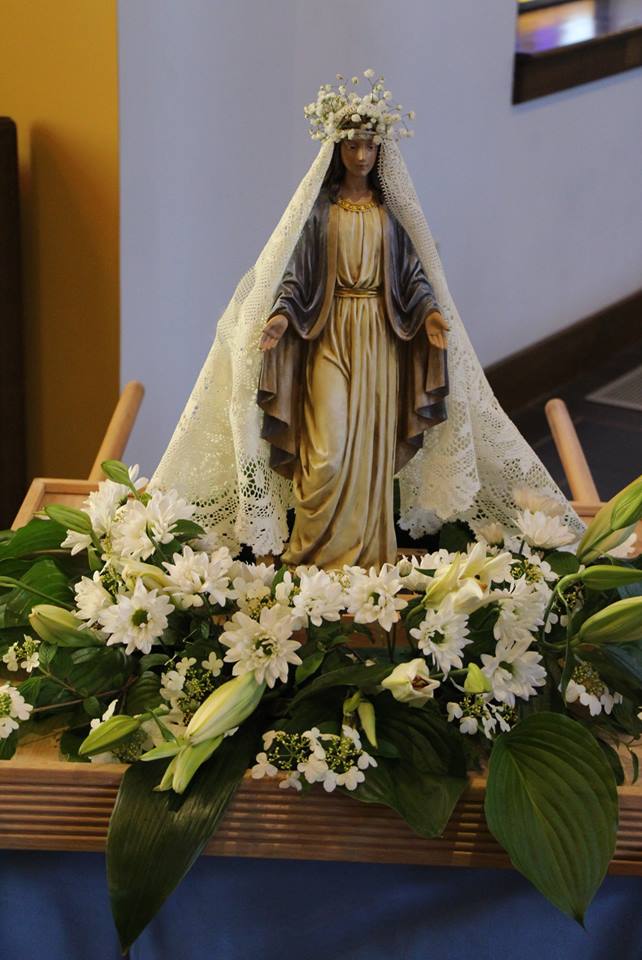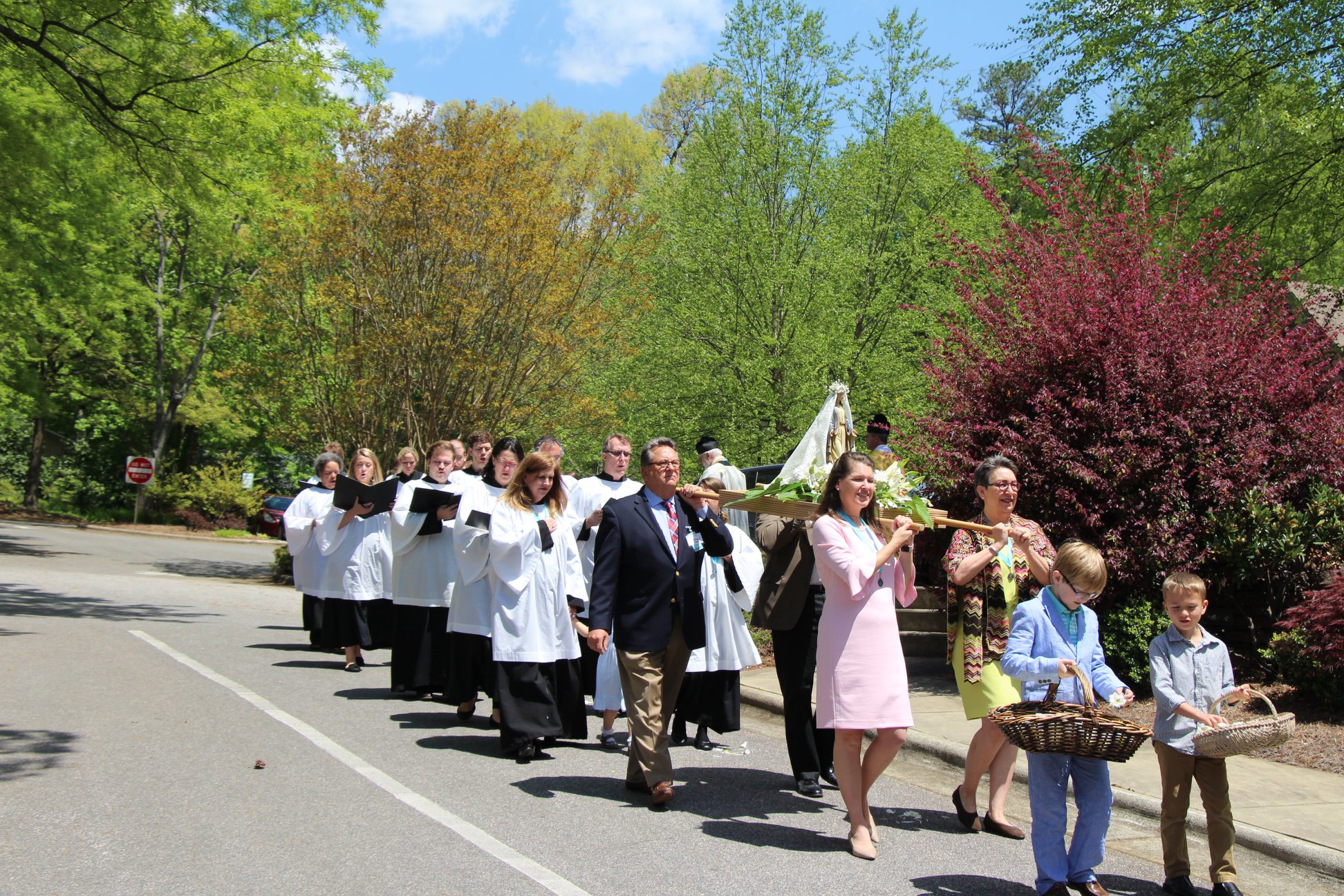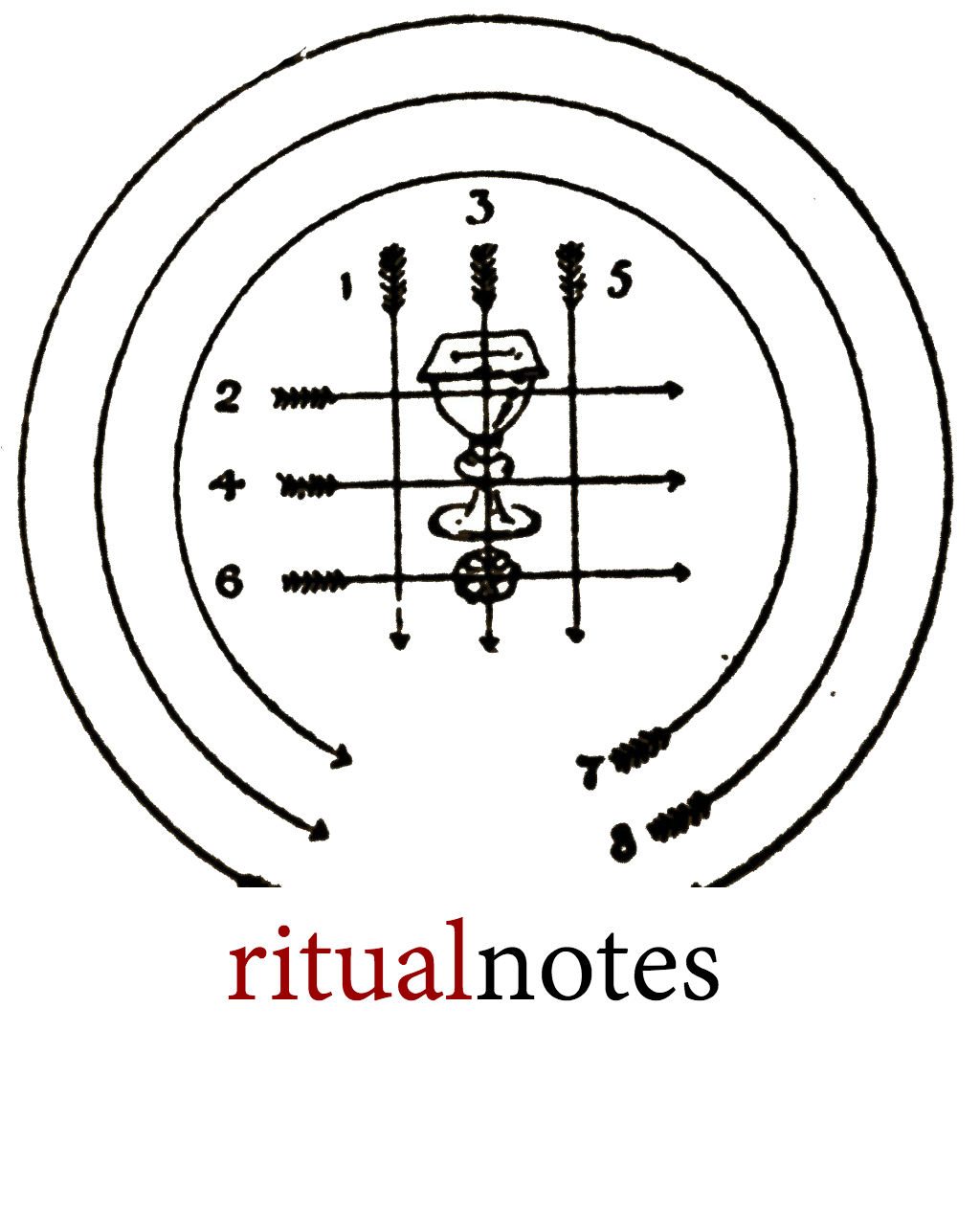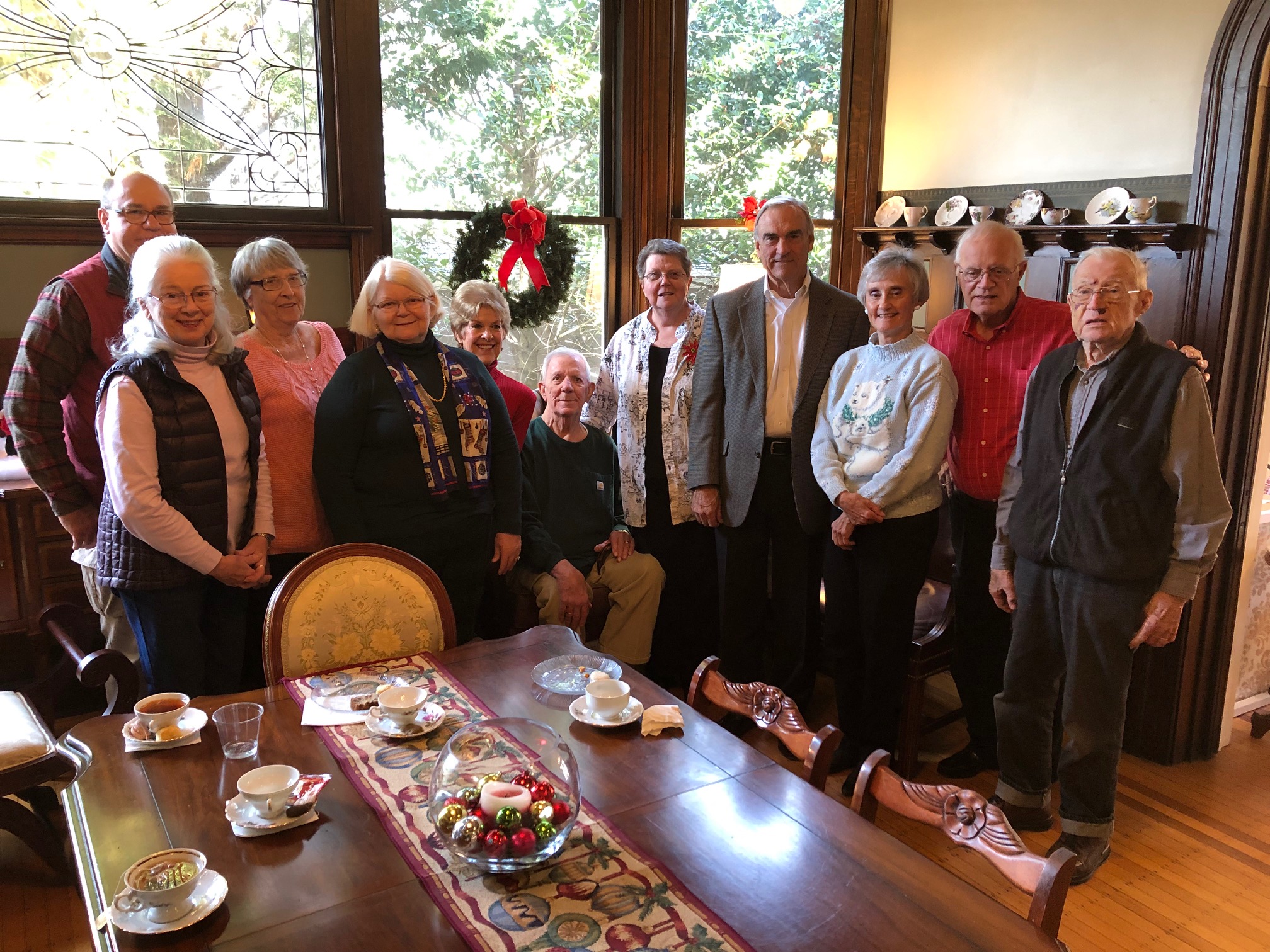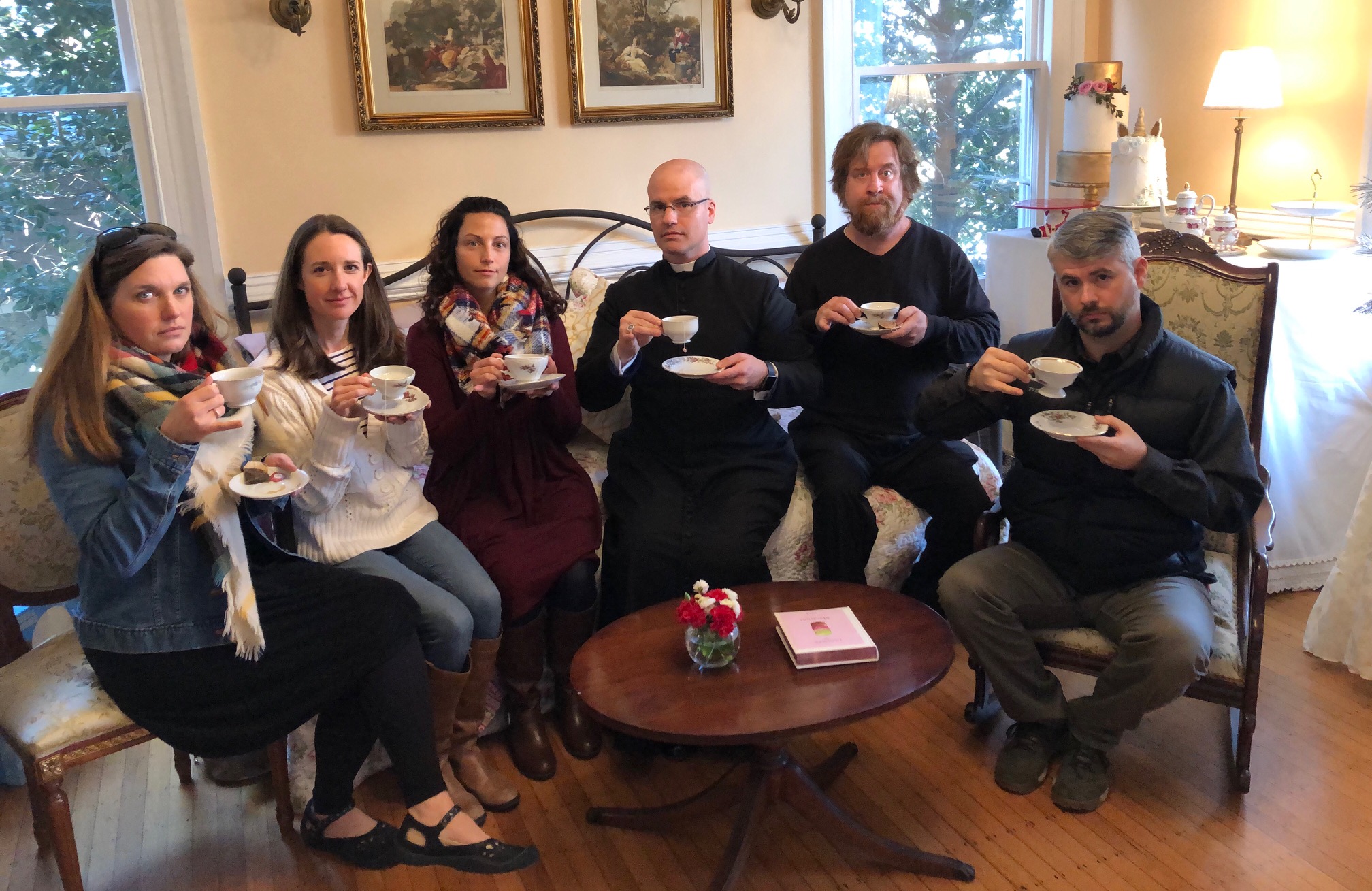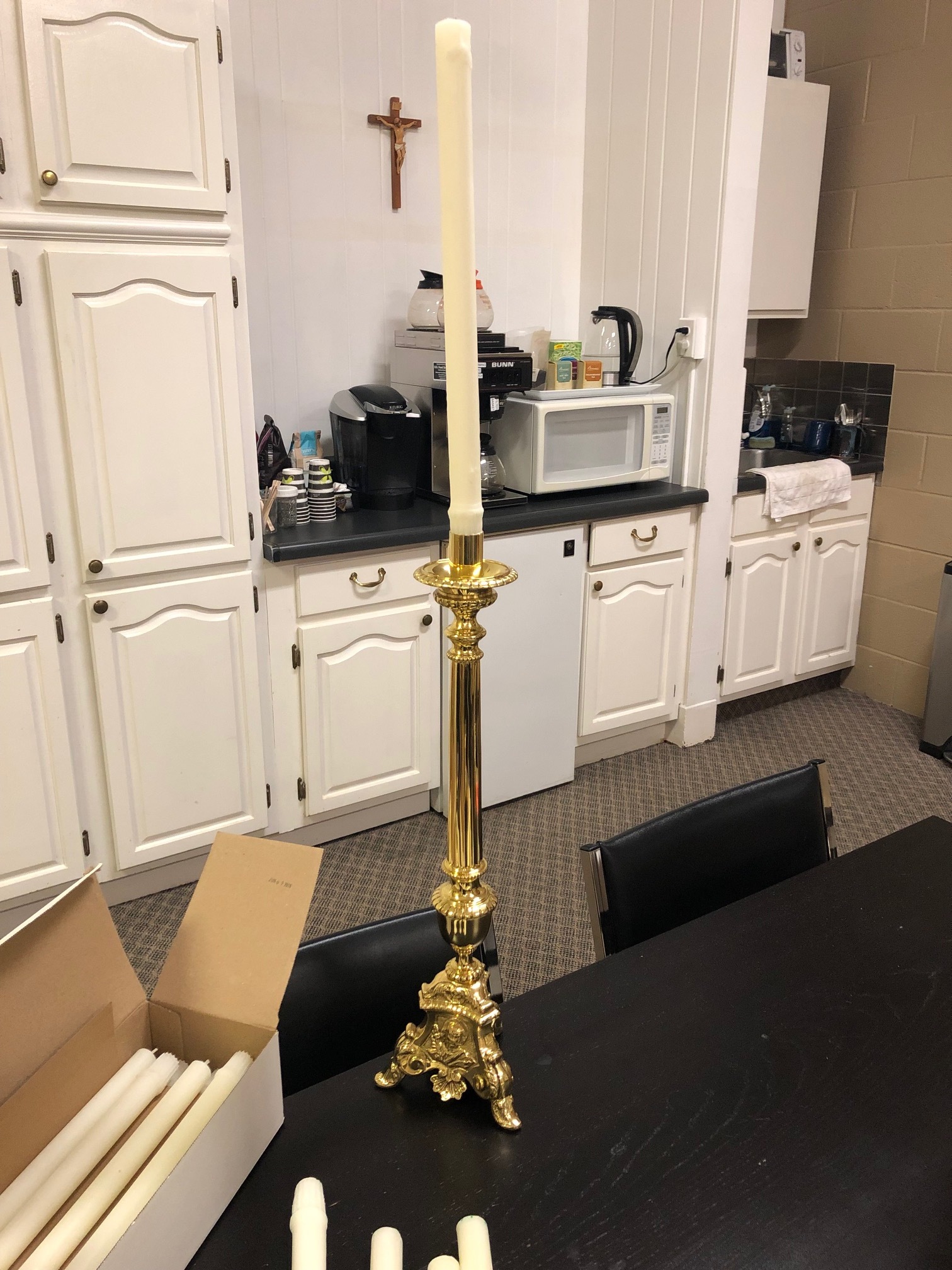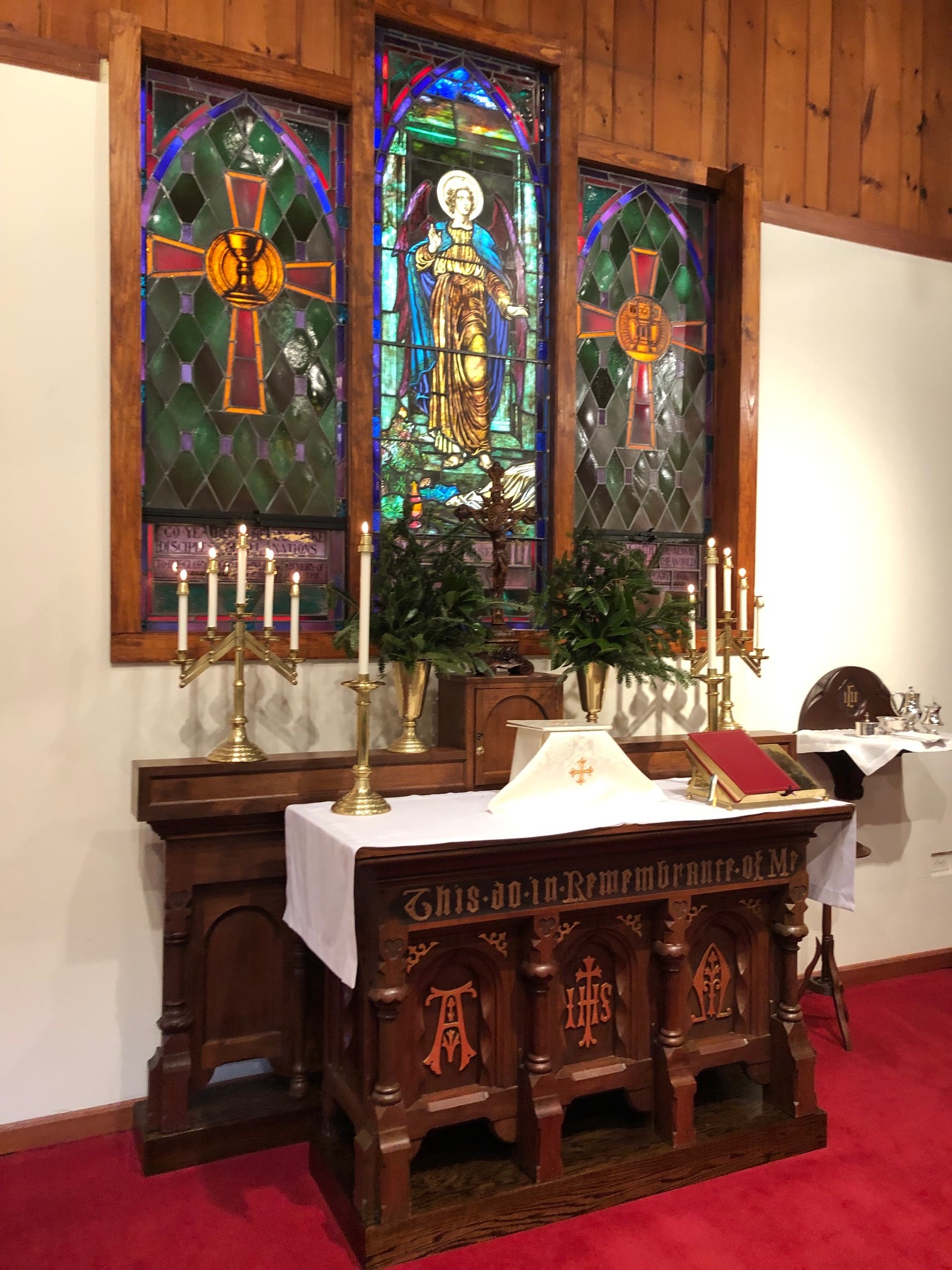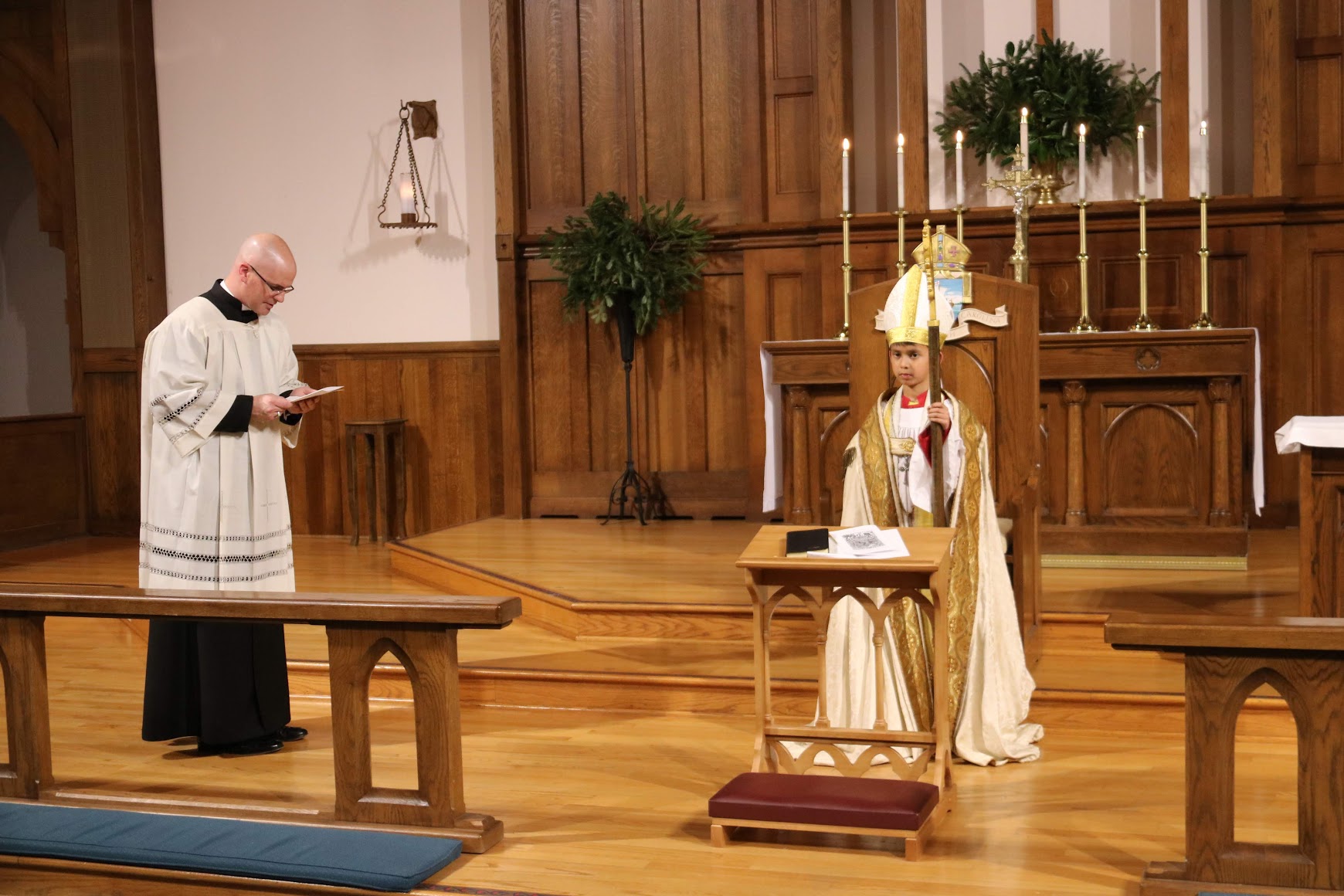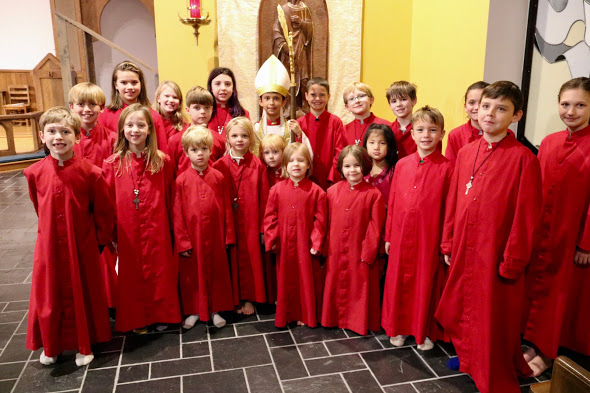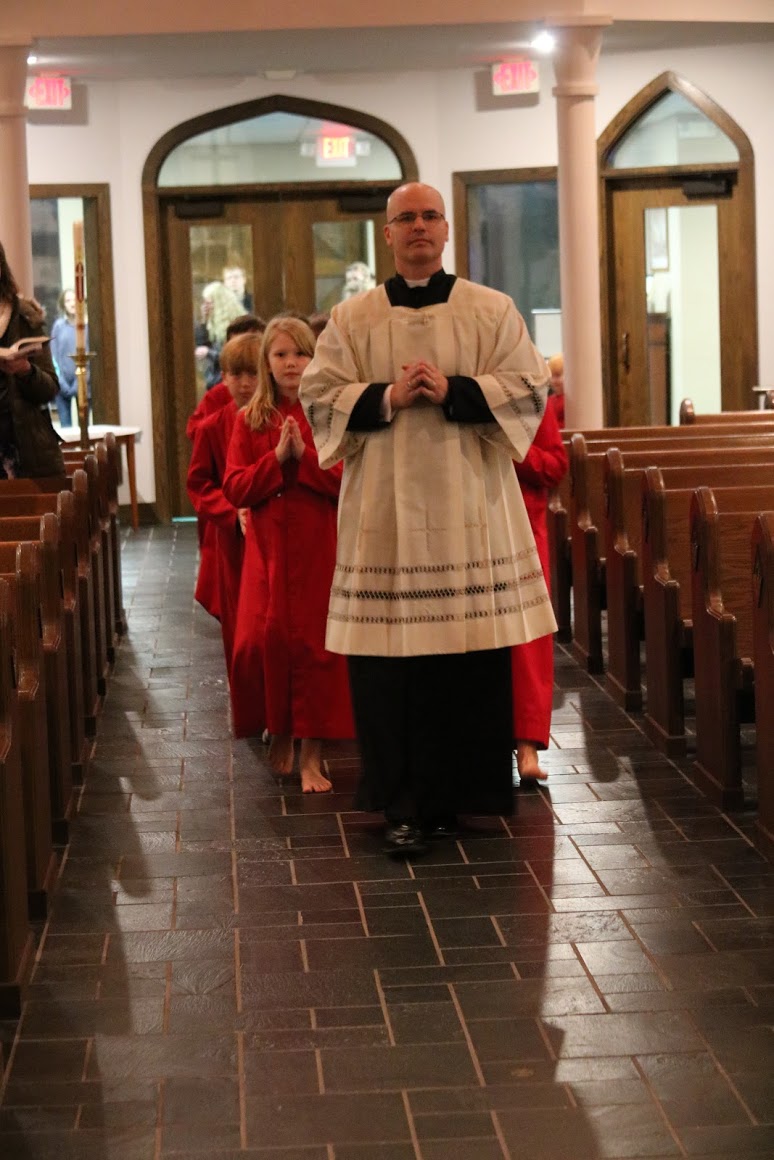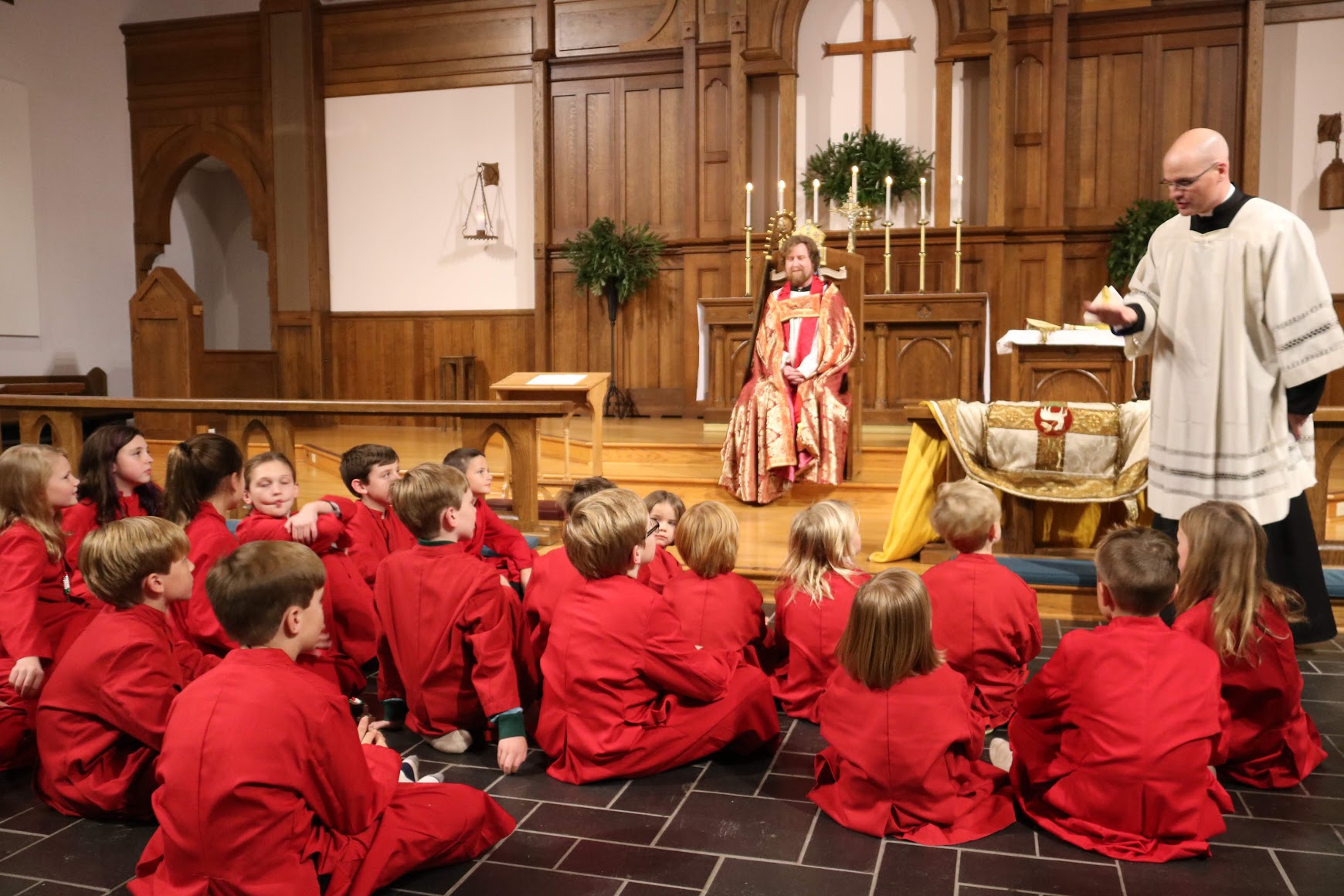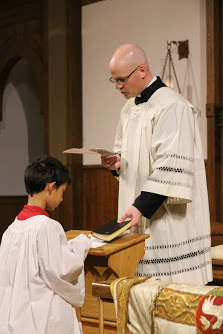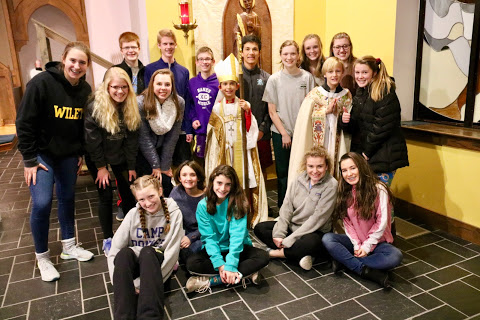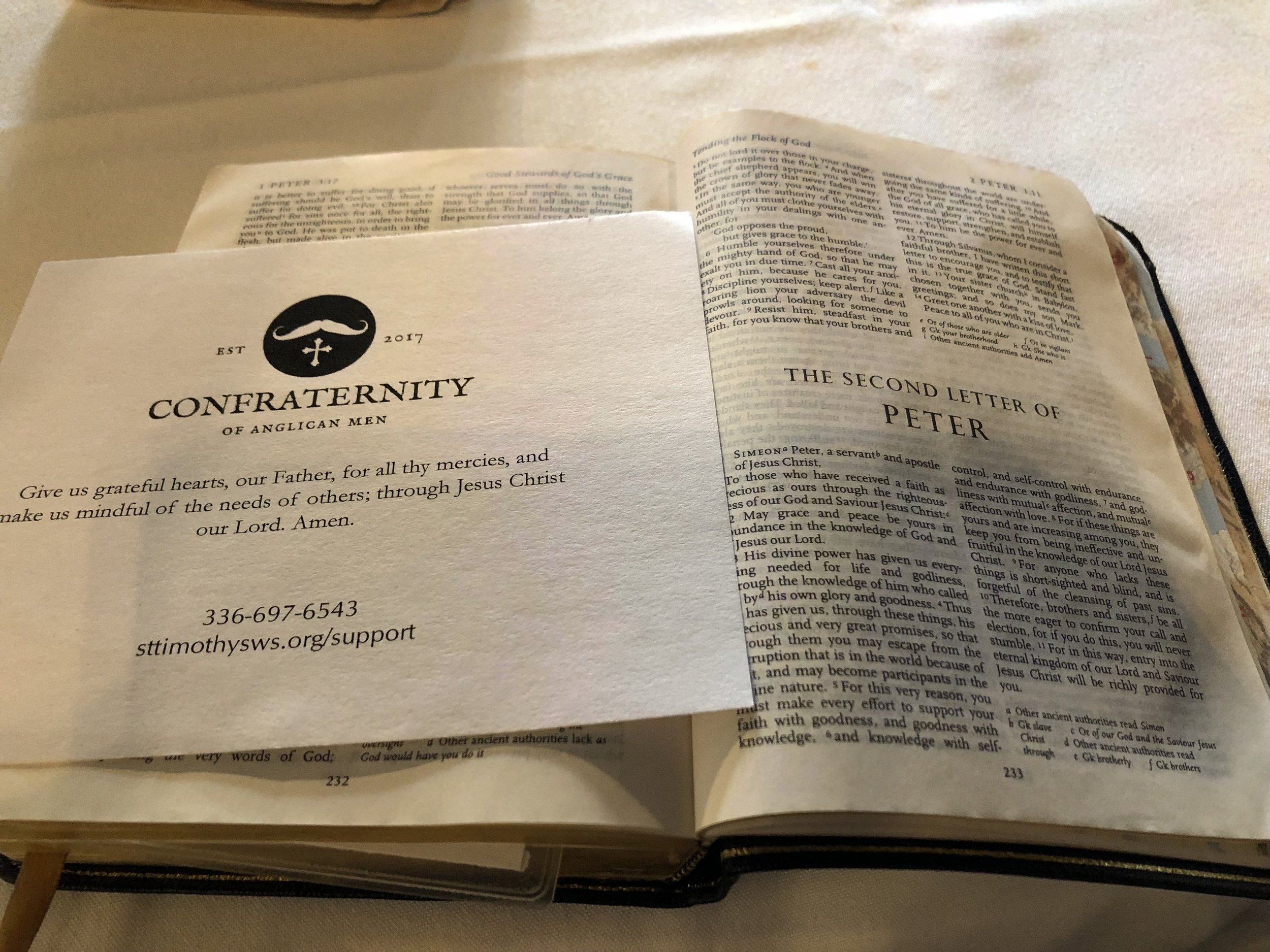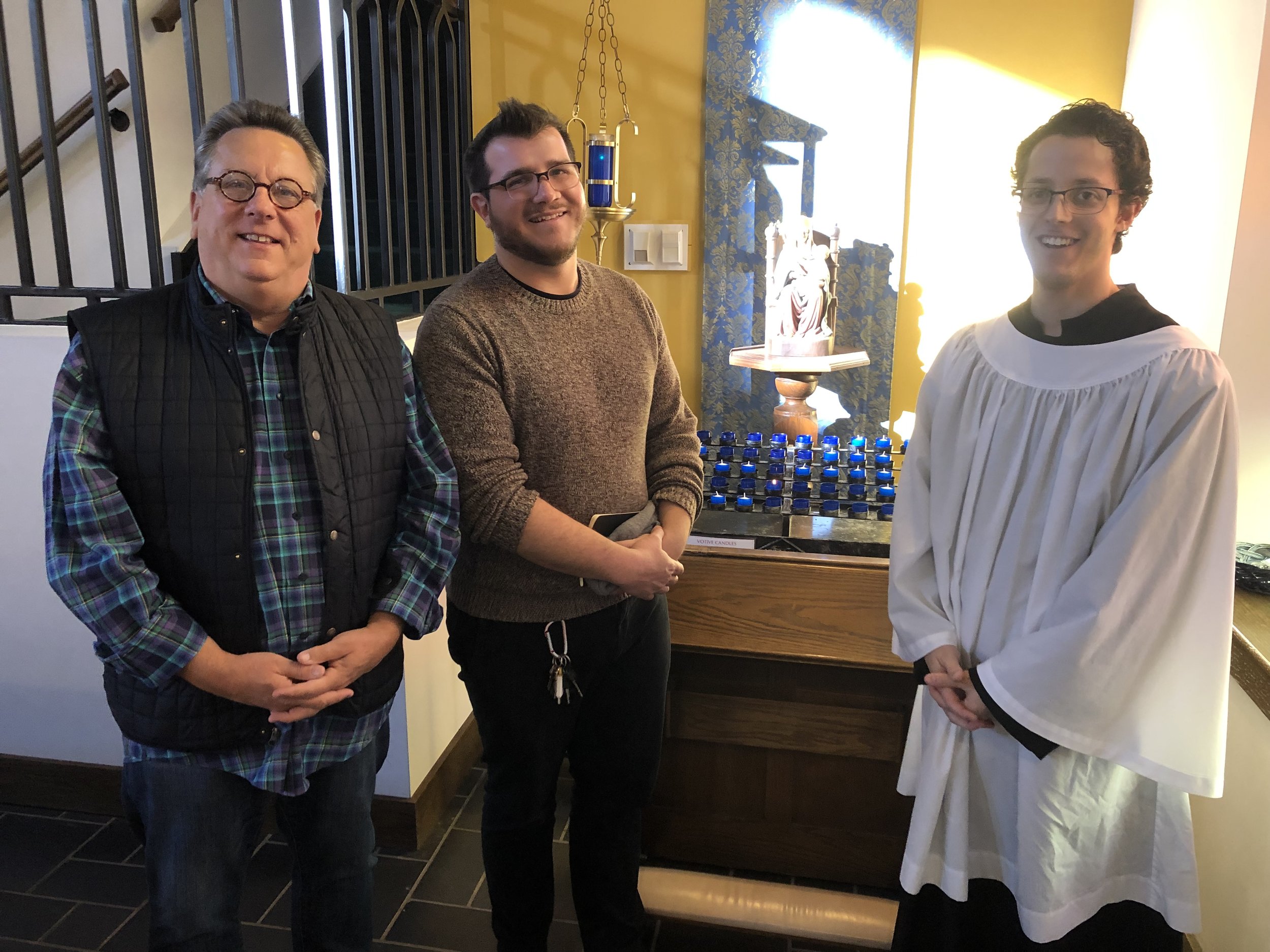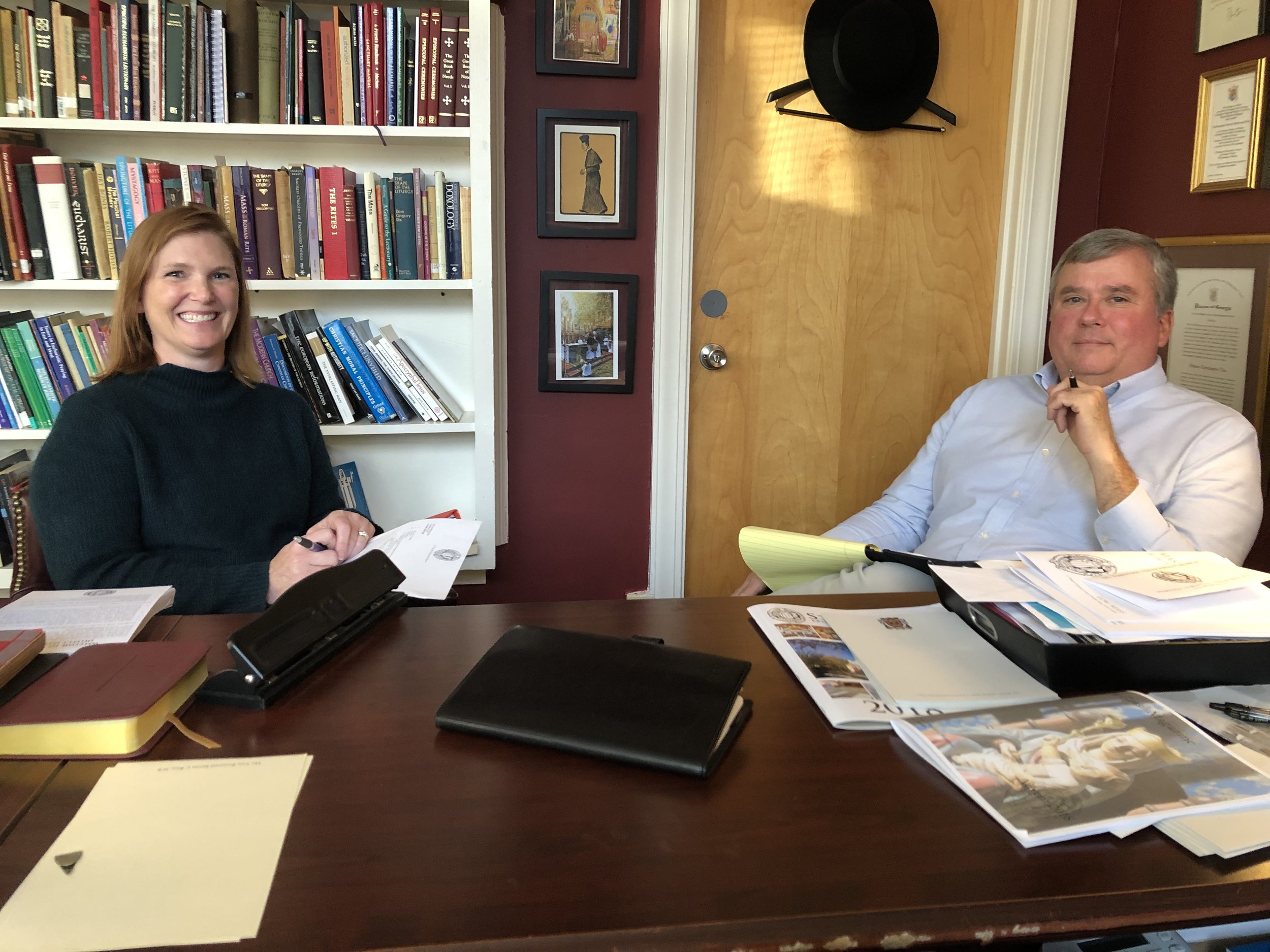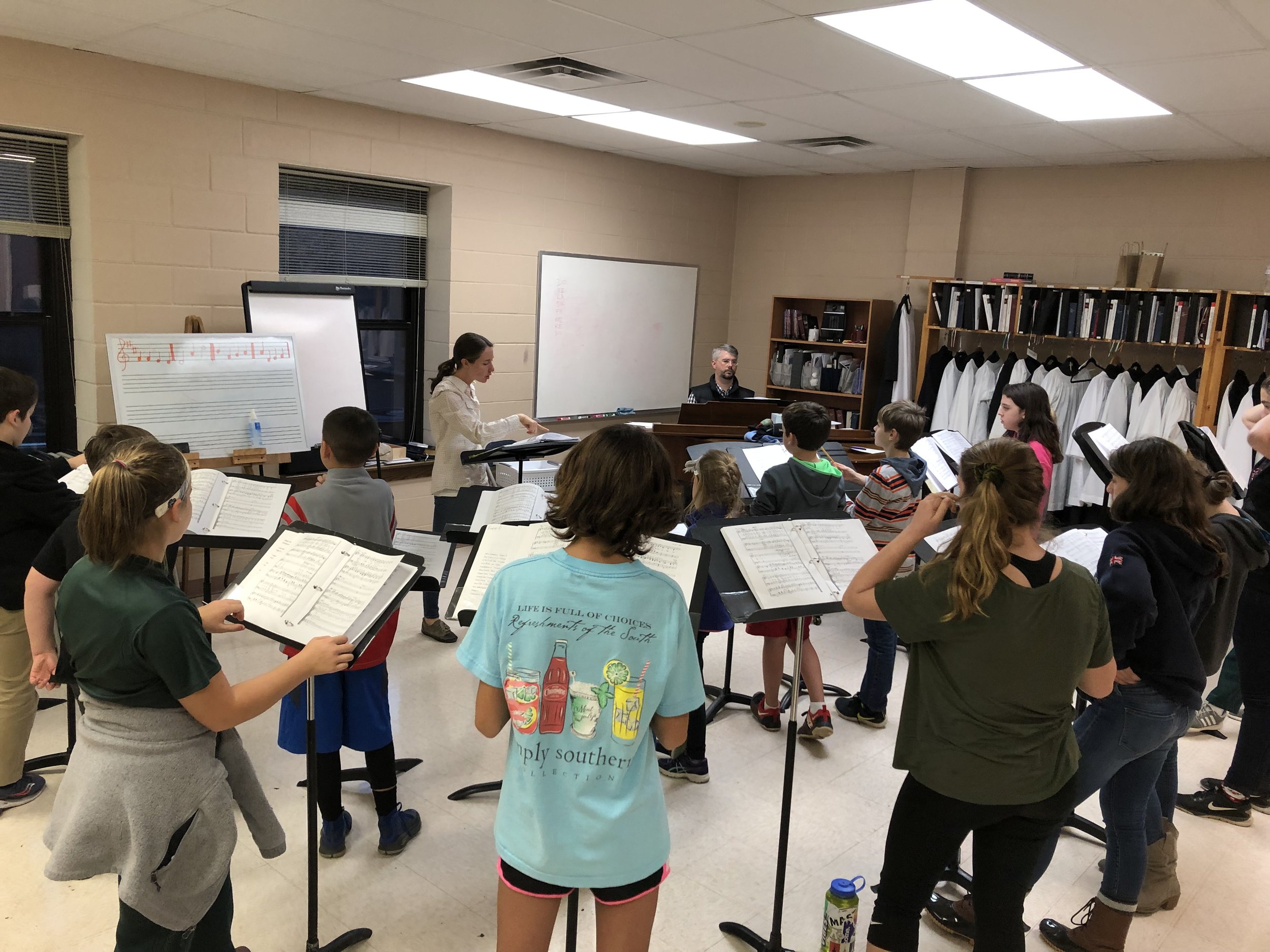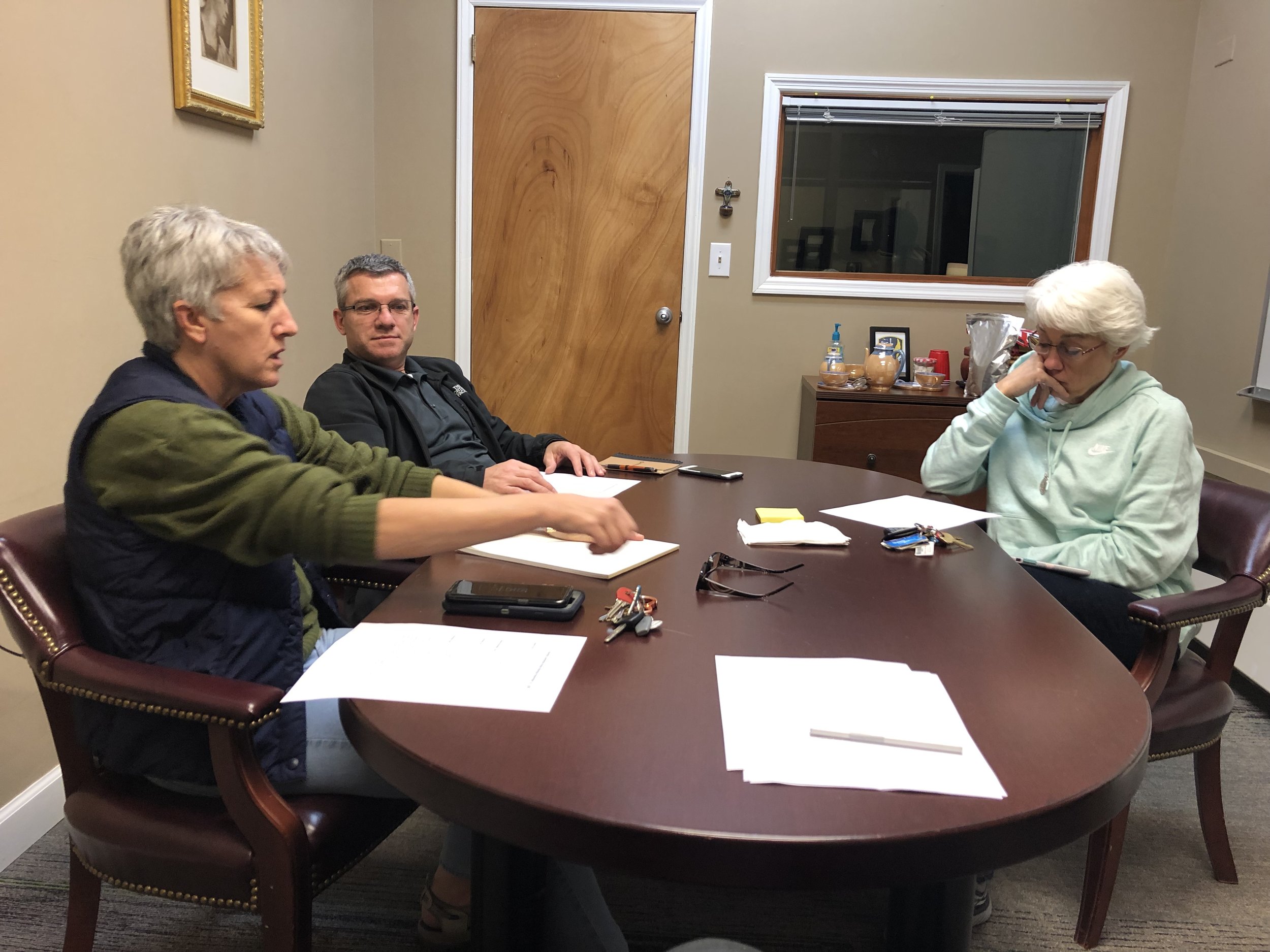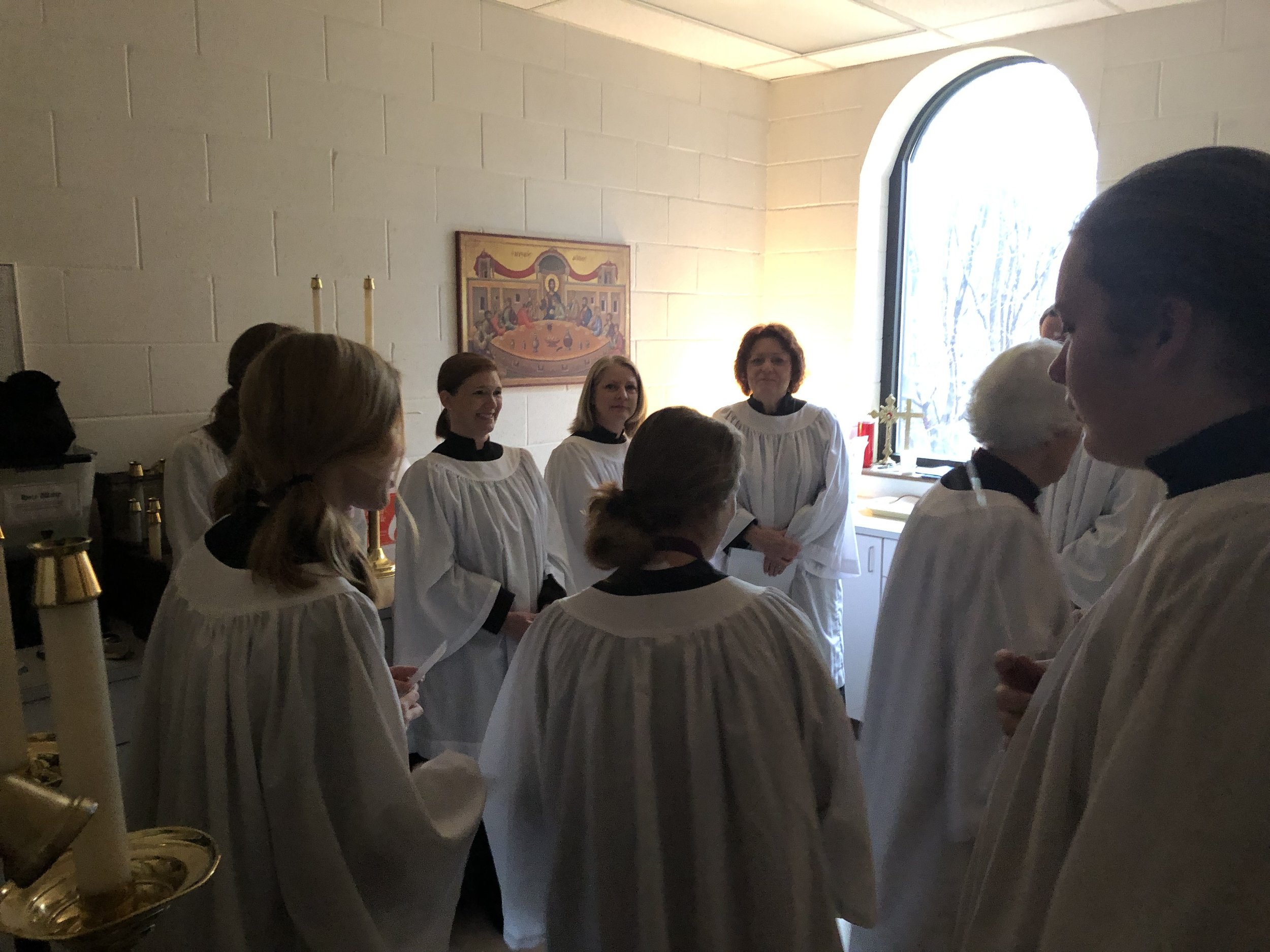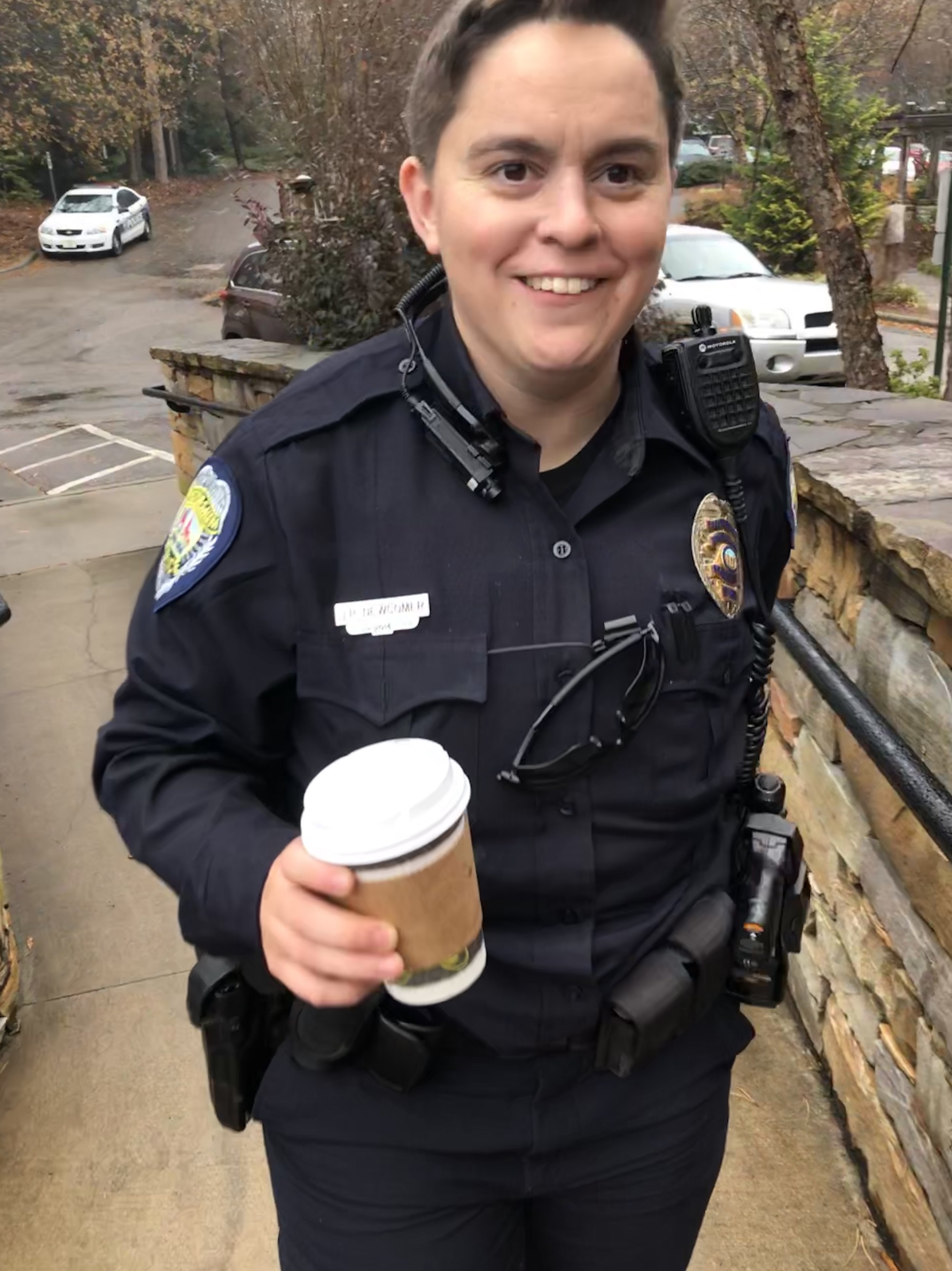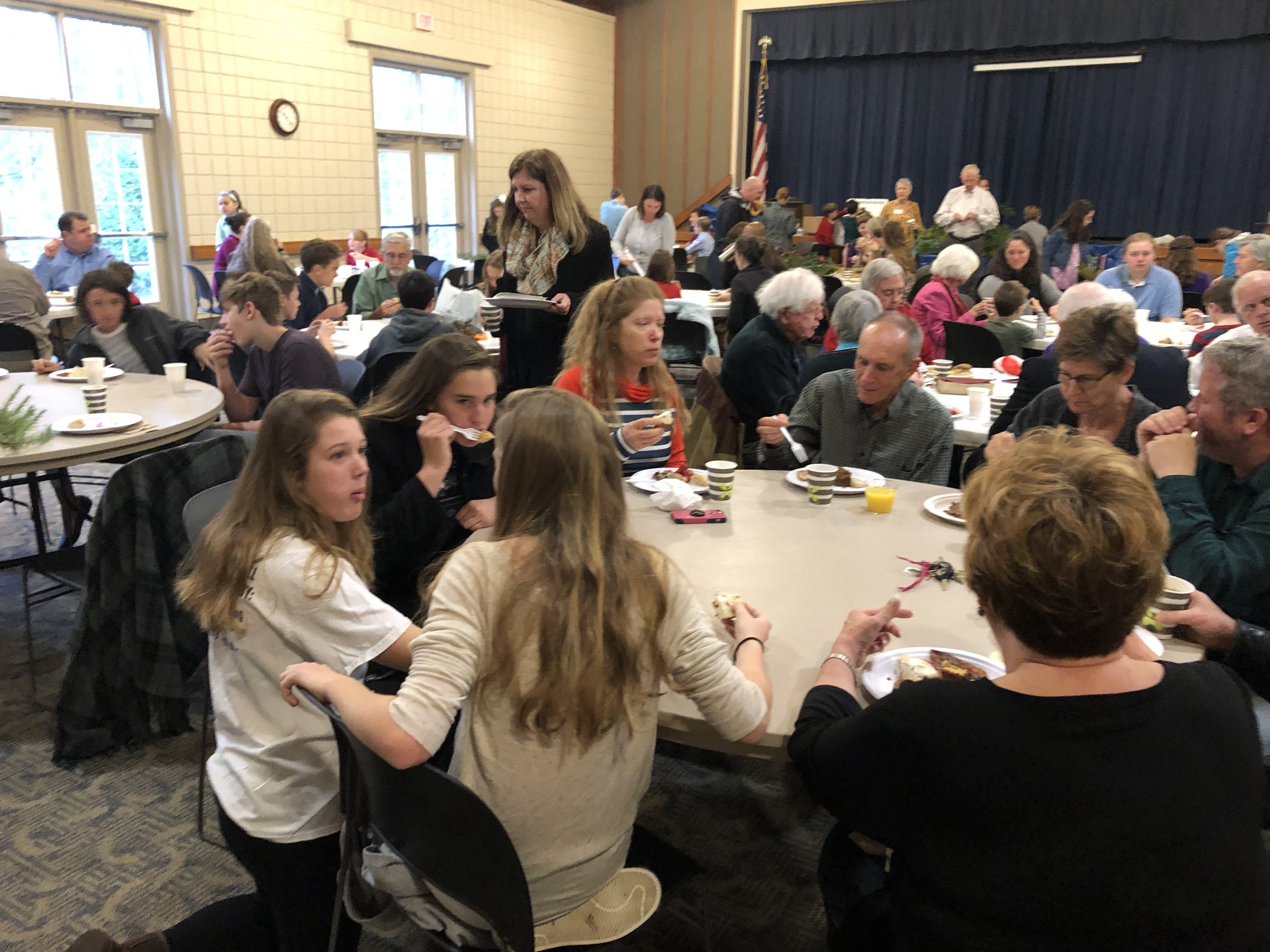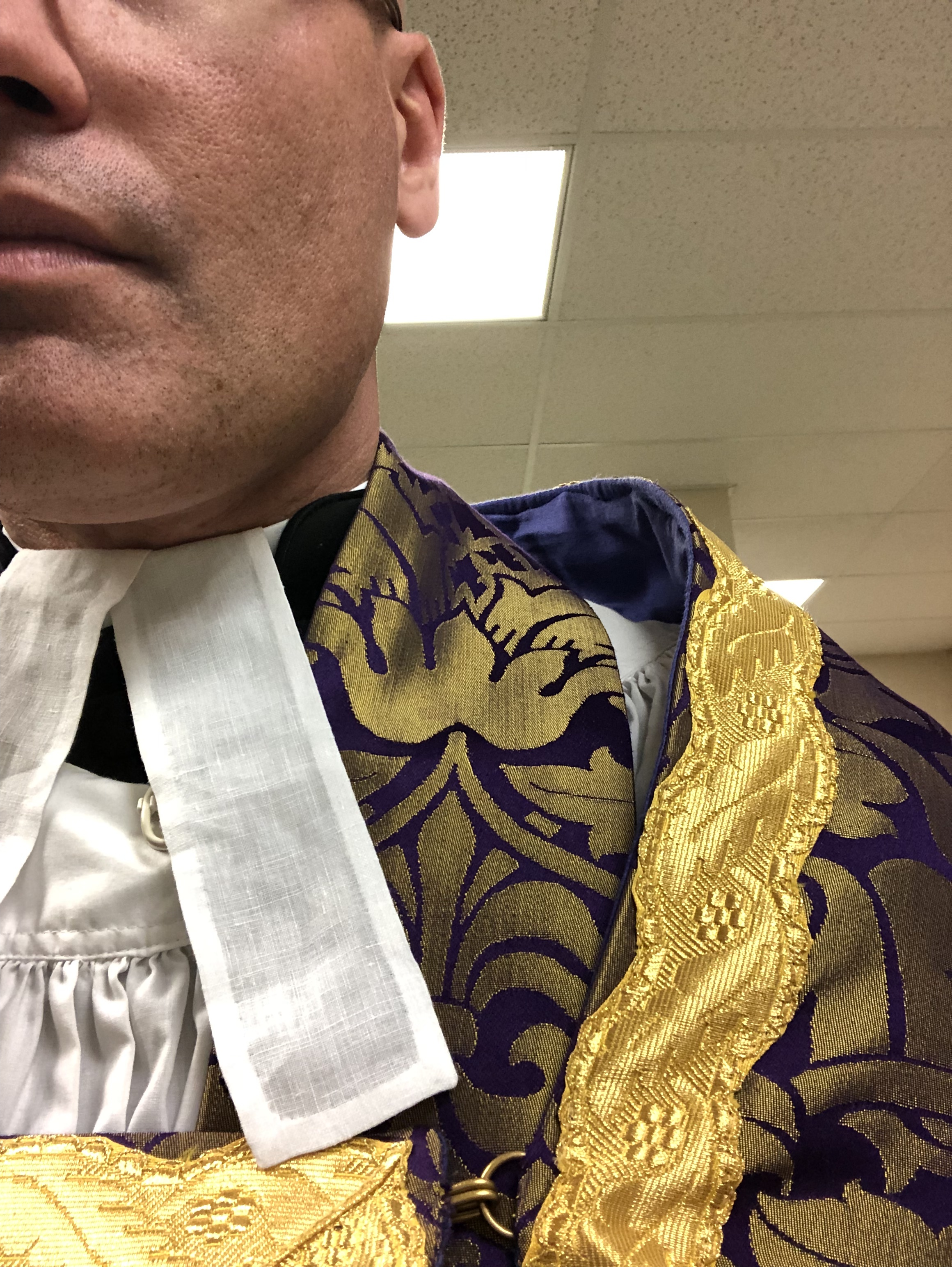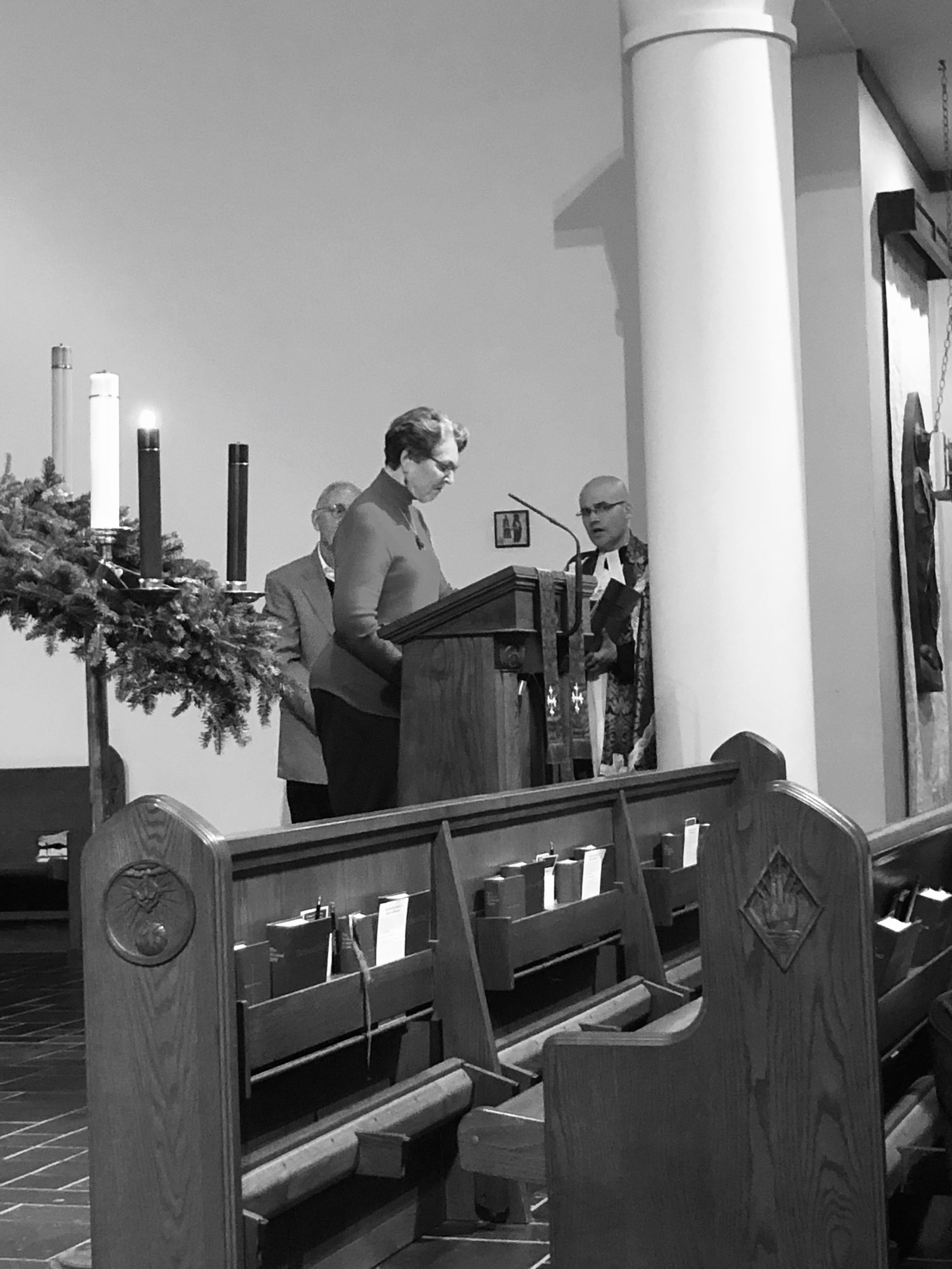
BLOG
Immaculate like snow, December 7-8, 2018
The old joke about clergy is that we only work one day a week, and an hour at that. The irony is that my letter of agreement provides for only one day off a week (technically one continuous 24-hour period). 24 hours in a row rarely happens, but my Fridays and Saturdays are usually slower.
Pics, or it didn’t happen.
Friday morning I said Morning Prayer at home by the tiny gas fire. Away from the church, I pray the office as used by St Stephen’s House in Oxford. I absolutely love it, especially the hymns. After the office, I went to the grocery store to get something for lunch and to grab some milk in case we didn’t have enough during the storm. Turned out we had plenty (3 gallons!). For the past year or so I have abstained from flesh meat on all Fridays, save solemnities. Lunch was broiled salmon and asparagus. After lunch I binged a couple of episodes of Luther on Netflix.
In the afternoon I made a hospital visit and then went with the family to procure a Christmas tree. It’s hard to wait too long to have a Christmas three with three children, and it was the eve of the Immaculate Conception, so why not? I said the first evensong for the Immaculate Conception and noted the Snowmaggedon prophecy:
“He giveth snow like wool
and scattereth the hoarfrost like ashes.
He casteth forth his ice like grains
At his frost the waters cease to flow.”
147.16-17
Saturday I said the office and mass at the Church for the Immaculate Conception (commemoration of the Advent Feria). I know the Immaculate Conception is quite the controversy among Anglicans, but I think it need not be. The 1662 Book of Common Prayer, still the official Prayer Book of the Church of England, includes December 8 as the Conception of the Virgin Mary. Furthermore the ARCIC (Anglican-Roman Catholic International Commission) document: Mary: Grace and Hope in Christ, said in 2004:
that the teaching about Mary in the two definitions of the Assumption and the Immaculate Conception, understood within the biblical pattern of the economy of hope and grace, can be said to be consonant with the teaching of the Scriptures and the ancient common traditions (paragraph 60);
I’m sure there will be time to say more on this at a later date. The rest of the day was spent being a biological father: basketball games, birthday parties, etc. Due to the impending 12-18 inches of snow, I cancelled Christian formation for Sunday but not the masses. As long as I can get to the Church, the sacrifice will be offered.
Evening Prayer by the fire, waited for the snow, and trusted that
“He sendeth out his word and melteth them
he bloweth with his wind and the waters flow again.”
147.18
Nothing Changes, December 6, 2018
The snow is coming. The local morning news meteorologists were hedging their bets on just how much, but it’s pretty clear something is coming. In the South, we lose our minds. We close schools, we raid the grocery stores for bread and milk (even if we never, ever consume them), and we consciously forget how to operate a motor vehicle. If snow comes, some churches will cancel services or, if they don’t, attendance is likely to be low. We won’t cancel. If I can physically get to the church, the Holy Eucharist will be celebrated. Even if no one shows up, like today.
Light coming in the sacristy.
It doesn’t happen often, but there are times when no one comes to mass. As long as I have server, mass is said. If I don’t have a server, I just say the office. While I always want a congregation, and the more the merrier, I do appreciate the empty chairs from time to time for the simple reason that nothing changes. Nothing. Mass is said for the benefit of the people, but it is done for God: “Pray my brother and sisters that my sacrifice and yours may be acceptable to God, the Almighty Father.” The prayers in the sacristy are the same, the approach to the altar is the same, communion is the same, everything is the same. Today might have been the Lord’s reminder that even if attendance is low because of the weather, the mass is critical whether or not there is a critical mass of people; there will always be the angels and archangels and all the company of heaven.
This morning the staff and I hosted our office volunteers to a tea party. For the past three years we’ve used a lovely downtown tea and coffee shop for this event. Our office volunteers help us by answering the phone, working on publications, and any number of important tasks that come up in a church office. It’s nice to spend some time with them when neither of us is running around like our head is cut off. I am very fortunate (and I know it) to have the best colleagues in Christendom. I try to be the best leader I can be, but I am quite aware how I must drive them mad sometimes. We posed for our annual tongue-in-cheek photo. We are missing one member, our sexton, but we’ll get him in the picture someday. We take our faith seriously but not ourselves.
When we arrived back at the church, I discovered that St Nicholas had visited, and on his feast day no less! Sitting by the door were two large boxes with six new candlesticks that I found on sale. Our current altar candlesticks are wobbly and, frankly, cheap. These new ones aren’t expensive either, but they are a step up. There is a venerable Anglo-Catholic tradition of using cheap materials to make candlesticks, altar crosses, etc., not because we like cheap things, but because we desire beauty and use whatever we have as an offering to God. These candlesticks are slightly shorter than our current ones and I had to order taller candles (23 ½”).
This week’s Holy Doodles. Click picture to enlarge.
I spent the rest of the afternoon tying up administrative loose ends: talked to a priest brother on the phone, talked to another friend with a prayer request, booked a flight for a visiting preacher, talked to a colleague about our shelter plans in the event of heavy snow and how to cover the needs on Sunday morning, wrote the weekly newsletter article on why we are no longer using a processional cross for the Gospel procession, etc. I also picked the winner of the Holy Doodle. Some years ago I started placing a blank box on the back of the worship bulletin for children (or adults) to doodle during the liturgy. Children, especially, listen better when they can focus their energy on something productive. I absolutely love to see what they come up with. They draw pictures based on my homily or the liturgical season or the lessons. They always find a way to connect.
The Shrine of St Timothy
Evening Prayer came and the Shrine Prayers went. It’s getting dark so early now that Evening Prayer feels like Compline. When I returned to the office, I worked hard to empty my inbox. I try to have it zeroed out by the evening, but this has been difficult the past month. I’m always afraid I serve my email rather than my email serving me. I try to reign it in and not to obsess over it. Today, I was delighted to discover the snooze button on my Gmail account. Now I can snooze important emails to reappear closer to the time I actually need to respond. The day ended with a text exchange with a police sergeant. She was asking if her officers could use our Law Enforcement Chapel for food and rest during the snow. That’s why it’s there and that’s why we are here.
Boy Bishop, December 5, 2018
I never know who will come to mass each day. There are a handful of folks who try to come everyday, the schedule allowing. I have four servers who take turns, again, depending on their availability. On Wednesday I can usually expect the most diverse congregation of the week, and today was no exception. I don’t make overtures to any particular demographic. I am of the conviction that if the church is indeed catholic, then all sorts and conditions will be drawn into her fold. Not to oversimplify things, but I think that if we keep the power of the Gospel and the Sacramental Life of the Church central, the demographics will take care of themselves. I took this picture after mass this morning (Clement of Alexandria, commemoration of the Advent Feria). The parish as a whole isn’t this diverse, but we are moving toward it by moving always deeper into the life of Jesus.
As soon as mass was over I had a meeting to plan a funeral. The deceased is not a member of the parish, but the extended family is. Unless there is some extraordinary reason, I do not turn down funerals, as it is a corporal work of mercy.
Next was my weekly Bible Study at 10:30am. I wish I could do more of them and I wish I could do them at times when more working folks can come. I enjoy my weekly group. We look at the lectionary texts for the coming week. This helps them prepare for Sunday, but maybe even more importantly, it helps me. I enjoy seeing where people go with the texts when they first hear them, their intuition, and their questions. Some times I can anticipate where they will go, but oftentimes, I am way off the mark.
On Wednesdays, we have another mass at noon. This mass is in the original church and has a dedicated, consistent congregation. At lunch I sat in a corner and watched recorded portions of President George H. W. Bush’s funeral. When I watched the end of President George W. Bush’s tribute, I failed to keep it together. I don’t know what the folks at the restaurant thought; grown man in a dress (cassock), crying in the corner while staring at his phone. I’ve heard stories from colleagues “in the know” about President Bush’s faith and his activity as a churchman. From all accounts, he’s very sincere with real devotion. I’ve always liked the Bush family and today we prayed for the President’s repose. From what I could see, the funeral was very well done, straight Book of Common Prayer, Rite II. I’m not big on Episcopal Church tribalism and I’m not a fan of the slogan “Episcopal Branch of the Jesus Movement.” I know what Bishop Curry is getting at but I think it unintentionally creates theological problems. That being said, the funeral did show what the Episcopal Church, as English Catholicism, does well and I hope the beauty and the intimate solemnity will warm the heart of the cynic.
In the afternoon, I met with a retired bishop from the Anglican Province of America. He asked if I would help him raise money for Vacation Bible Schools in Cuba, something I’m very pleased to do. I’ve known this bishop for a couple of years and he frequently worships with us. I know, on some levels, the relationship between the Episcopal Church and Continuing Anglican jurisdictions is complicated, but a real source of irritation for me is how the governing bodies seem to have no desire for reconciliation. We have more in common with them than any other American Christian body but there is no desire to work together, pray together, and hopefully, be together once again. We’ll do what we can on the ground in this portion of God’s vineyard.
After Evening Prayer and Shrine Prayers, we prayed the rosary at the Shrine of Our Lady of Walsingham (Joyful Mysteries). I love praying the rosary. I’m always distracted when we start. I’m always thinking of what has to be done next and the first decade seems like it takes forever. But then the mind quiets and the prayers do their work and, every single time, I’m sad it ended so soon.
Then it was time for my most favorite event of the year – the Installation of the Boy Bishop. I jokingly told the congregation that I love this night because I get to vest people as bishops and then tell them what to do! This is our seventh year keeping the Boy Bishop tradition. The kids take it so seriously and one really gets the feeling that the tradition teaches – the birth of Jesus Christ turned power upside down. The lowly have been lifted up and the mighty have been scattered. Our Boy Bishop is chosen from the 5th grade boys. Not to leave the girls out, a 5th grade girl is chosen to carry in the Bambino in the church on Christmas Eve.
Our Christmas Eve pageant rehearsal followed the St Nicholas Festival and Boy Bishop Installation. My role in the pageant is to be the narrator. The hard work, and the due credit, goes elsewhere. It’s going to be an old fashioned Christmas Pageant which, in my opinion, is the best kind.
After the rehearsal I went to the overflow shelter to greet the volunteers. While I was there, the bus pulled up with the night’s guests, so I went out to greet them too. Six blessed souls walked through the door and the day ended the way it began and the way it unfolded - with diversity.
Tuesday, December 4, 2018
Fr. Wilson
I once read that Fr Wilson of Haggerston used to set three alarms, starting at 5 in the morning. The first alarm was across the room and would require a walk across a cold linoleum floor. I can sympathize. If I had to choose an identity as either a morning person or night owl, I would have to choose morning, but I do not jump out of bed like a coiled spring. I wish I could tell you I wake well before dawn for meditation and study, but I do not. I should; the great ascetics warn against lingering bed in morning.
I was scheduled to wake at 5:10 this morning so I could be at the Overflow Shelter at 5:30 to assist with check-out. This season, Tuesday mornings will be my mornings. My colleague sent me a text last night saying there was no need to come in, as the census was low and we had plenty of folks on hand. I had planned to come in anyway and meet the new volunteers, but when the alarm went off, alas, I had no cold linoleum floor to walk across. I rolled over and slept in until 6:30am.
When I arrived at church, my server was already busy in the sacristy placing the newly arrived sanctuary lamps in the cupboards. To my horror, I saw the candles were yellow, but they were clearly not pure beeswax. Instead of announcing the Sacramental Presence of Our Lord, the candles look like a glowing stick of butter. They have been sent back.
Mass was for the Feast of St John of Damascus with the Advent Feria commemorated. After mass, we said the Angelus at the Shrine of Our Lady of Walsingham where the light, for the past seven days, has been extraordinary on these late autumn mornings. The image of OLW is the only thing illuminated by the rising sun.
After breakfast (my standard: grande dark roast and red-pepper egg whites from Starbucks), necessary administrative tasks, and the weekly staff meeting, I went downtown to our bi-weekly men’s lunch, Confraternity. We’ve been meeting at a trendy coffee shop/bar connected to an independent bookstore. It’s a perfect venue and centrally located for many of the men. I look forward to these gatherings. As I wrote yesterday, the Church needs more men. Men need the Church. This is a way for us to get together and talk about the things that are on our mind and ground them in our faith in Jesus Christ.
When I returned the office, I had some administration to tend to, including the identification of the graves in the Society of Arimathea cemetery. I discovered we’ve actually cremated/buried 24 children (and not 23 as previously reported) since 2017 and there are five currently buried in our cemetery with two to be buried at a later date. The need has outpaced our ability to plan and we are making decisions on the fly without having adequate time to think everything through. For instance, we don’t yet know how to permanently mark these graves nor do we always have a name for the child. Oftentimes, I only have the last name of the mother. This is certainly the case for two children that were left unclaimed at the morgue. Someone suggested we adopt the Moravian practice of Beatus and Beata for the babies. I am very fond of this idea. I am grateful for colleagues and leaders who are flexible and patient as we do so much so quickly.
Before Evening Prayer I had a pre-marital counseling session for a wedding at the end of the month (Christmastide). I barely made it to my stall by 4:45 and ended the day with Evening Prayer and Shrine Prayers. Quick trip home for some grilled chicken and then off to basketball practice (son’s, not mine!) where I composed and sent out the parish email on the gym’s wifi.
We'll Leave the Light on For You | December 3, 2018
I believe Motel Six was the hotel chain that would always end their commercials with the comforting tag line, “We’ll leave the light on for you.” What a wonderful image of vigil; we’ll stay awake and ready for whenever you find your way here.
I usually arrive at St Timothy’s around 7:30am on weekdays (Morning Prayer is at 8:15 and mass follows). When I open the church doors, the inside is quiet and the lights are off, but it’s not completely dark. There is, more times than not, a single votive candle burning at the Shrine of Our Lady of Walsingham. Early in the morning, a medical professional comes in the church to pray. I imagine she prays for herself, her family, and those who will be in her care that day. I also trust she prays for the parish and its priest. She lights the candle and by doing so, leaves the light on for us. I always get the feeling that we are a relay of prayer. She has come in before dawn and we take over from there. The altars of the church are always warm, never allowed to grow cold due to dormancy.
Today’s mass was for the feast of St Francis Xavier with a commemoration of the Advent Feria. To my shock and delight, it was a congregation of men. I’m sure it’s happened before, but I can’t remember. I know it’s not politically correct to say, but it’s true, we need more men in the church. Men are disengaged through lack of challenge, catechesis, and cult. I was pleased to have two seminarians today, one from Wake Forest and one from Duke. There is hope for the future.
After mass, I had eggs and coffee with our Wake Forest Divinity School intern. We meet every Monday morning, usually over coffee, to discuss his internship and to solve most of the theological problems of the world. After breakfast I heard a confession and spoke with a husband who just lost his wife at a young age. Her funeral will be 19th for this year, the most ever for me in a year. It’s been a difficult season for death.
After a simple lunch of canned chicken and bread and butter pickles (not as bad as it sounds), I spent the afternoon in weekly meetings. I met with a member of the vestry, then both of my wardens. We use these meetings to stay up-to-date with the fast pace of the parish and I keep them informed of what is going on and ask their counsel for any issues or decisions that might be tricky. We also spend a lot of time in laughter.
At 4:45pm it was back in the church for Evening Prayer and Shrine Prayers. The first lesson from Second Peter was beautiful. To strengthen faith we need goodness and goodness needs knowledge. Knowledge needs self-control. Self-control needs endurance. Endurance needs mutual affection. Mutual affection needs love. At the Shrine of St Timothy, we concluded our prayers for the day, with the day’s intention for missionaries, since it is the feast of St Francis Xavier.
After Evening Prayer, I peeked in to listen to the chorister’s rehearse (they are so very good), and it was back for a final standing meeting of the day – with my liturgical leaders. We recently started meeting to review the previous Sunday and to tweak anything out of whack. It is so helpful when they can anticipate my thoughts and I can anticipate theirs.
Out of the church just after 6pm and off to hear my daughter’s school orchestra concert. As I drove by the parish hall, I saw the preparations for tonight’s shelter guests. The light was on.
Advent I, December 2, 2018
Our King and Savior draweth nigh.
I don’t know what other Christians in our area did today, but we did our bit to reset the month of December properly in the anticipation found in Advent. Average crowd at the masses (around 307, I think), but not the overwhelming December crush of people that rectors dream about instead of sugarplums. I think it’s harder every year to “do church.” When I first started parish ministry (ahem, 19 years ago), people would come to church just because you unlocked the door. A bit of an exaggeration, but the point is there. Two decades later our culture, yea, even Southern Culture, no longer supports, let along promotes, life schedules that are grounded in the practices of faith.
But here we stand, or rather, here we kneel. In the midst of Santa Claus, Rudolph, and Free Shipping, we await our King and Savior.
We had five at the shelter on our first night – one came late. They were all gone when I arrived at 6:40am. The lights in the parish hall were all off, resting until they’ll be turned back in just a little while.
I do love our violet vestments for this season. Made by Mr. Luzar in England, it’s a heavy Roman cut. As this is the beginning of the ecclesiastical year, I made some tweaks to our liturgy, slowly but surely adapting based on practicality and personnel. We finally removed the crucifer from the Gospel procession, properly keeping the focus on the Gospel Book as the icon of Jesus Christ. The homily was a bit of a risk, although they never come out nearly as risky as I imagine them. I preached on the Advent themes of judgment and hell, not deeply, but directly. Between the 9am Low Mass and 11am Sung Mass, we had our monthly parish breakfast, this time couple with an Advent Wreath workshop.
After the masses, we had an information meeting for our Holy Land Pilgrimage next July. 29 of us will be walking in the footsteps of Our Lord. This will be the second pilgrimage I’ve led here, and the first to Israel. I was last in the Holy Land 20 years ago. I’m sure the landscape hasn’t changed, but I know I have. I’m very much looking forward to this trip. One of my dreams is to be the Rick Steves of Ecclesiastical Travel. Can’t you see me on the Travel Channel with a film crew visiting all the amazing holy sites in Christendom? If you can’t, I’m doing it for you.
Advent Lessons and Carols finished the evening. A couple hundred souls came to hear the readings and anthems and carols. Following a Lessons and Carols used at Salisbury Cathedral, we included the Greater Antiphons before 8 sets of readings. My youngest son, Luke, helped light the Advent Wreath. The choir did amazing, as they always do. It’s one of the few liturgies where I have very little to do but sit back, close my eyes, and let the choir do the heavy lifting.
The highlight of Lessons and Carols was the reading by Mrs. Catherine. Her story is extraordinary. Several years ago she had a massive stroke. I remember being with her at the hospital and the doctor telling her husband that she might have a working vocabulary of 7-10 words. In the years that have passed she has worked so very hard to prove the doctors wrong, something I’m certain they are happy to concede. Her vocabulary has to be in the hundreds, if not thousands. Along with her husband, she read a lesson from one of the sets. This is the second time she has read a lesson since her stroke. The Lord will open our lips and regardless of what we think of our ‘performance,’ our mouth will show forth his praise.
Holy Domesticity, December 1, 2018
For years, Fr. T.E. Jones’s blog was mandatory reading, at least for me. For seven years, Fr Jones recorded the priestly and parochial life of St Peter’s, London Docks, where he was vicar. I loved his blog, which concluded in 2013, for its domesticity. Fr. Jones didn’t just record the major events at St Peter’s; he shared the beauty of the routine and mundane. It was a real look into the real life of a real parish. This May I was thrilled to meet Fr Jones, now retired, at the National Pilgrimage at Walsingham. He was gracious, charming, and witty, exactly as I had imagined.
While not done with social media (still very useful for parish communications), I am certainly over it. I am tired of the rancor, snark, and virtue signaling (am I now virtue signaling the fact that I don’t virtue signal?). I would much rather ‘follow after the things which make for peace, and the things wherewith one may edify another’ (Romans 14.19).
While I am certainly Fr. Jones and I do not serve the famous St Peter’s, London Docks, I do have a desire to share the holy domesticity of parish life, for both a record and, God willing, edification.
Saturday, December 1, 2018
Commemoration of Nicholas Ferrar, Deacon
I had the pleasure this morning of leading an Advent Quiet Day in the parish, sponsored by the Daughters of the King. Mass was for the commemoration of Nicholas Ferrar, a patron saint of holy domesticity. I have never been to the little church of St John’s at Little Gidding, but very much hope to one day correct that.
At the Quiet Day, I discussed the iconography of three images of the Virgin Mary: Mary, Ark of the New Covenant, the Seven Sorrows of Mary, and Our Lady of Walsingham. I find the image of Mary as Ark of the New Covenant profound in its parallels to David before the Ark in 2 Samuel. I’ve always had a devotion of the Mater Dolorosa and hope this title will help those in attendance find consolation in the strength of Our Lady, who endured so very much. And Our Lady of Walsingham is just so very special. When I enter the church every morning, she greets me as if it where my own mother wishing me good morning from the kitchen.
After a simple lunch with the retreatants, I went to my office to work on my Spanish. On Wednesday, I received a call from the pediatric decedent affairs coordinator asking if the Society of St Joseph of Arimathea would pay for the cremation of a 22-week-old. The answer, of course, was yes. It will always be yes. This was the 23rd child in less than two years we’ve taken care of. Friday afternoon, the funeral home called to tell me the family had changed their mind about keeping the ashes and asked if we would bury as well. Again, yes, Always, yes. Our wonderful sexton, John, responded to a quick text to see if he could prepare the grave on very short notice and he completed the grave within the hour. The family was coming by our infant cemetery at 2pm and I knew they spoke very little English. My Spanish can’t be much better than their English. I took four semesters of Spanish in college but I am really not able to do more than struggle through my order at our favorite Mexican restaurant.
We lack suitable liturgies for the burial of children in the Episcopal Church. The 1928 Book of Common Prayer is far better, but I don’t have a copy in Spanish. It was committal only at 2pm, so I pieced together some prayers and practiced. When the family arrived in two cars, I met them in the parking lot and did my best to say, “I am sorry my Spanish is not good, but we pray to God from the heart.” We walked in the drizzle down to the cemetery and buried the tiny urn with broken hearts and broken Spanish, trusting that God will heal and hear both.
The afternoon was spent with a pot of tea and computer screen, working on the next day’s homily, the first Sunday of Advent.
After watching my eldest son’s basketball game, I drove back to the church at around 8:30pm to welcome our guests to our homeless shelter. Tonight is the first night of our 122 day season (our sixth). With the rain and dropping temperatures, I was surprised (but happy) to only greet four guests, faces that were both familiar and brand new.
One new guest was over at the out-of-tune piano and filled the space with music. The space in the room wasn’t the only thing her music filled.
The Gift of All Souls
For the first time in my priesthood, I will say all three traditional requiems for All Souls. I am singing the first mass on the evening of All Souls and I said the second and third masses this morning. This issues and history surrounding bination and trination might be interesting to some and they are easily found on the internet along with the development of saying three masses on All Souls. I am more interested at this moment in the devotional and pastoral effects of this tradition.
Traditionally, the first mass is for all the faithful departed, the second and third are for personal intentions and the intentions of the Holy Father. (If a priest is to sing a mass, he sings the first one, regardless at one time it is offered.) I deviated and said the masses this morning for the faithful departed of St Timothy’s, my parish, and for the repose of my mother, who died in 2010. The pastoral result is that I have journeyed in my prayers and offering at the altar from the personal (my mother), to my pastoral duty in praying for the departed of my parish, to my connection and obligation to pray for all the departed in the Body of Christ. While I could certainly remember all three at a single All Souls’ Requiem, it has been an honor to slow down and remember each group with deliberate intention.
I know that praying for the dead is still somewhat controversial in Anglicanism and the notion of purgatory strikes some as a fond thing vainly invented without any warrant of Scripture. But let us not forget Judas Maccabeus praying for the dead in 2 Maccabees 12.42ff. “For if he were not expecting that those who had fallen would rise again, it would have been superfluous and foolish to pray for the dead.” Instead, it is a holy and pious thing. Indeed, it has been.
The Oxford Movement Begins
Most Anglo-Catholics know that 185 years ago today, John Keble ascended the pulpit at the University Church of St Mary's in Oxford to deliver the sermon at the opening of the Assize Court.[i] If the date is not remembered, the result certainly is. John Henry Newman wrote that this sermon, easily forgotten during any other time, was the beginning of the Oxford Movement.[ii]
19th century sermons, to be sure, are not always pleasure reading. Compared to our modern tolerance of sermon length and substance, our forebears preached long sermons with often dense and complicated arguments. The opening of the Assize Court was also not a Royal Wedding. It’s content would naturally address the connection of law and religion and the congregation would not be made up of wool spinners from Norfolk. Yet this sermon, entitled National Apostasy, is unexpectedly good. Once you get through the dense beginning and understand the building argument, it not only speaks clearly to the times in 1833 but it has a remarkable resonance in 2018.
A month after Keble preached this sermon, Parliament passed the Church Temporalities Act. This act, for financial reasons, reduced the number of archbishops and dioceses for the established (Anglican) Church of Ireland. The law said in part:
“And whereas the Number of Bishops in Ireland may be conveniently diminished, and the Revenues of certain of the Bishopricks, as well as the said annual Tax, applied to the building, rebuilding, and repairing of Churches and other such like Ecclesiastical Purposes, and to the Augmentation of small Livings, and to such other Purposes as may conduce to the Advancement of Religion, and the Efficiency, Permanence, and Stability of the United Church of England and Ireland: And whereas the Tenure by which Church Lands are held in Ireland is inconvenient, and it is expedient to alter the same in such Manner as may tend to the Ease and Security of the Church, and the Advantage of the Persons holding thereunder:’ (emphasis mine)
Keble found this act by the Whig government an affront on the rights of the Church. Even if the Church of England is the Established Church, members of Parliament, who may or may not share the Christian faith, have no business deciding how many bishops the Church needs. Rather than being the act of a rogue government ignoring the will of the people, Keble recognized it was the indifference and apathy of the people to allow such legislation to be debated.
Using the prophet and judge Samuel as a model, Keble used his Assize Sermon to diagnose the apostasy in England and prescribed the medicine for healing. In a nutshell, this is Keble’s argument:
Like Samuel’s Israel, we prefer the lure to live in prosperity and so-called freedom like other non-Christian nations. Nations, and by-extension individuals, find justification for throwing off the yoke of Christ and the demands of discipleship. We look to threats outside and threats within to abandon godly principles (sound familiar?). We then blame government or religion for our ills and never ourselves. We rationalize and excuse every decision and act. We become so tolerant that we believe nothing and we persecute those who believe in the name of inclusion (oh my goodness!). This rebellion moves from individuals to public officials. The officials begin to attack Christ by attacking His Church, beginning with apostolic authority – bishops. This attack will come in the name of popularity and expediency; see the words I highlighted in the Church Temporalities Act above.
Keble calls the Church to follow the example of Samuel through constant intercession, which then gives grounding and strength to protest. Christians should continue to glorify God in their daily lives and routines and should not be so consumed with the concerns of the day that they neglect ordinary duties, especially prayer and devotion. This is an important point he makes. While we may not live to see wrongs righted, we are on the right and, ultimately, victorious side.
Every one of his points deserves further reflection and exposition, but is this not the climate of 2018?
The Catholic Revival in the Church of England had nothing to do with gin, lace, and backbiting, as is often caricatured. Yes, elaborate ritual and church building followed in the next generation, but this was a logical development of the belief that the Church is not the same as the Post Office. The Holy Eucharist is the source and summit of our lives and not the same as chicken tetrazzini at the weekly Rotary Club. The development of ritual and devotion was the servant, the handmaid, to the truths Keble turned our minds to 185 years ago.
Anglo-Catholics need to remember this sermon and why John Keble delivered it. Anglo-Catholics need to preach and live it.
Outline of National Apostasy
Full Text of the Sermon
I. The Old Testament is a guide, mirror, and warning during national instability
a. It is a natural and just reflection of the present time
i. To disregard the Old Testament as a guide for present concerns is “mistaken theology”
b. The judgment of nations in the Old Testament is analogous with the judgment of individual Christian souls, which God will ultimately reward or punish.
c. In the past it was quoted constantly, even ‘at random’ for any personal or societal ill, now it seems to have no authority in the hearts of men, however clear the Old Testament might be.
II. The Example of Samuel
a. Samuel was “the truest of patriots” whose example perplexes those who would suggest or act as if a nation (especially a Christian one) could prosper without God and His Church.
b. The people of Israel, despite God’s unique relationship with them, desired to live without His governance and the “the moral restraint implied in His peculiar presence and covenant.”
c. Israel’s rejection of God is a model temptation for any Christian nation who wonder if God has “forgotten to be angry with impiety and practical atheism” and believe that without God “they should be happier if they were freer, and more like the rest of the world.”
III. The Symptoms of a Nation Alienated from God and Christ
a. Israel demanded a king to be like other nations. Christian nations “avow the principle” that she is a part of Christ’s Church “on the plea, that other states, as flourishing or more so in regard of wealth and dominion, do well enough without it.”
b. The move away from God will come from two impulses
i. Declaration of outside danger
1. The Israelites were concerned about the Ammonites (I Samuel 11)
ii. Declaration of corruption within the nation
1. The wickedness of Samuel’s sons
c. Like the Israelites, justification for actions will be found
i. “Pretences will never be hard to find; but, in reality, the movement will always be traceable to the same decay or want of faith, the same deficiency in Christian resignation and thankfulness…”
ii. “And so, in modern times, when liberties are to be taken, and the intrusive passions of men to be indulged, precedent and permission, or what sounds like them, may be easily found and quoted for everything.”
iii. Samuel silenced this behavior with the reminder that the issue is motivation and purpose and not argument.
1. We are responsible for our motives and purposes in dealing with Christ’s Holy Church.
iv. Additional symptoms of an Apostate Mind in a nation
1. Growing indifference on the foundational matters of serious subjects
2. Viewing matters of religion and the Church as agents of exclusion
3. Shameful public conduct among officials (those bound by voluntary oaths).
a. Disrespect of Christ will begin with disrespect to the Successors of the Apostles (bishops).
b. “Suppose such disrespect general and national, suppose it also avowedly grounded not only any fancied tenet of religion, but on mere human reasons of popularity and expediency, either there is no meaning at all in these emphatic declarations of Our Lord, or that nation, how highly soever she may think of her religion and morality, stands convicted in His sight of a direct disavowal of His Sovereignty.” (This is as close as Keble gets to directly addressing the suppression of Irish bishoprics.)
c. The attack will address cult (Saul took it upon himself to sacrifice) and order (Saul persecuted David, God’s chosen).
IV. How an individual is to respond to national apostasy
a. The example of Samuel – “that combination of sweetness with firmness, of consideration with energy, which constitutes the temper of a perfect public man, was never perhaps so beautifully exemplified.”
i. Constant fidelity and intercession for the nation and her people.
1. “Having so protested, and found them obstinate, he does not therefore at once forsake their service, he continues discharging all the functions they had left him, with a true and loyal, though most heave, heart. ‘God forbid, that I should sin against the Lord in ceasing to pray for you: but I will teach you the good and the right way.’” (This is Keble’s text for the sermon.)
2. The Church should be constant in intercession and it is only by constantly praying for the leaders and people that they will be spared from hate and despair.
3. Only through prayer can the church protest (remonstrance), which is the duty of every Christian with the Church is under attack.
a. Samuel rebuked Saul, yet when he had to remove himself from Saul’s presence until his death, he mourned (I Samuel 15.35).
ii. Submission and Order
1. Christians should uphold the Church by faithfully executing their duties with trust and fidelity, lest they discredit the cause, even in the most menial task.
2. “Public concerns, ecclesiastical or civil, will prove indeed ruinous to those, who permit them to occupy all their care and thoughts, neglecting or undervaluing ordinary duties, more especially those of a devotional kind.”
V. The Ultimate Goal
a. It will be unlikely to see the victory in this life and there may be very few to sympathize with Christ’s call.
b. In the end, the Christian will be on the victorious side and that victory will be eternal.
[i] Assize Courts were periodic sessions of the High Court of Justice and find their origins in the Magna Carta. They were abolished in 1971.
[ii] Apologia Pro Vita Sua, page 50, Penguin Classics
Building a Litter
St Timothy's was very pleased to host the Annual Meeting and Mass of the Society of Mary, American Region on April 28. While technically a week early for the traditional May Devotion, we celebrated a votive mass for Mary (propers from the American Missal for a Saturday votive in Eastertide) and processed with a litter and image of Our Lady to an outdoor chapel where we concluded with the Regina Caeli. Not exactly St Silas, Kentish Town, but it was an earnest celebration full of devotion and joy.
In preparing for the celebration, I was planning on not having a procession of Our Lady for two reasons. First, we are not in an urban setting with a natural route for procession, and second, we do not have a litter. Furthermore, as familiar as I am with church goods catalogs, for the life of me, I cannot remember seeing a litter for sale. My conscience continue to nag, "you cannot have the national mass for the Society of Mary without a procession." Necessity is the mother of all invention, so we built one.
I have the pleasure of many creative, competent, and resourceful people in my parish, both on staff and among the laity. I gave my sexton the general idea and he came up with the follow design. The total cost for his materials was under $80.
Materials
- Sides - 5/8" x 3 1/4" Oak Casting - all joints were mitered cut; all connects were wood glued and brad nailed
- Top and Bottom - 5mm Oak Laminat
- Base for Our Lady - 3/4" x 2" Oak - screwed in from the bottom
- Dowels - 1 /14" x 6'
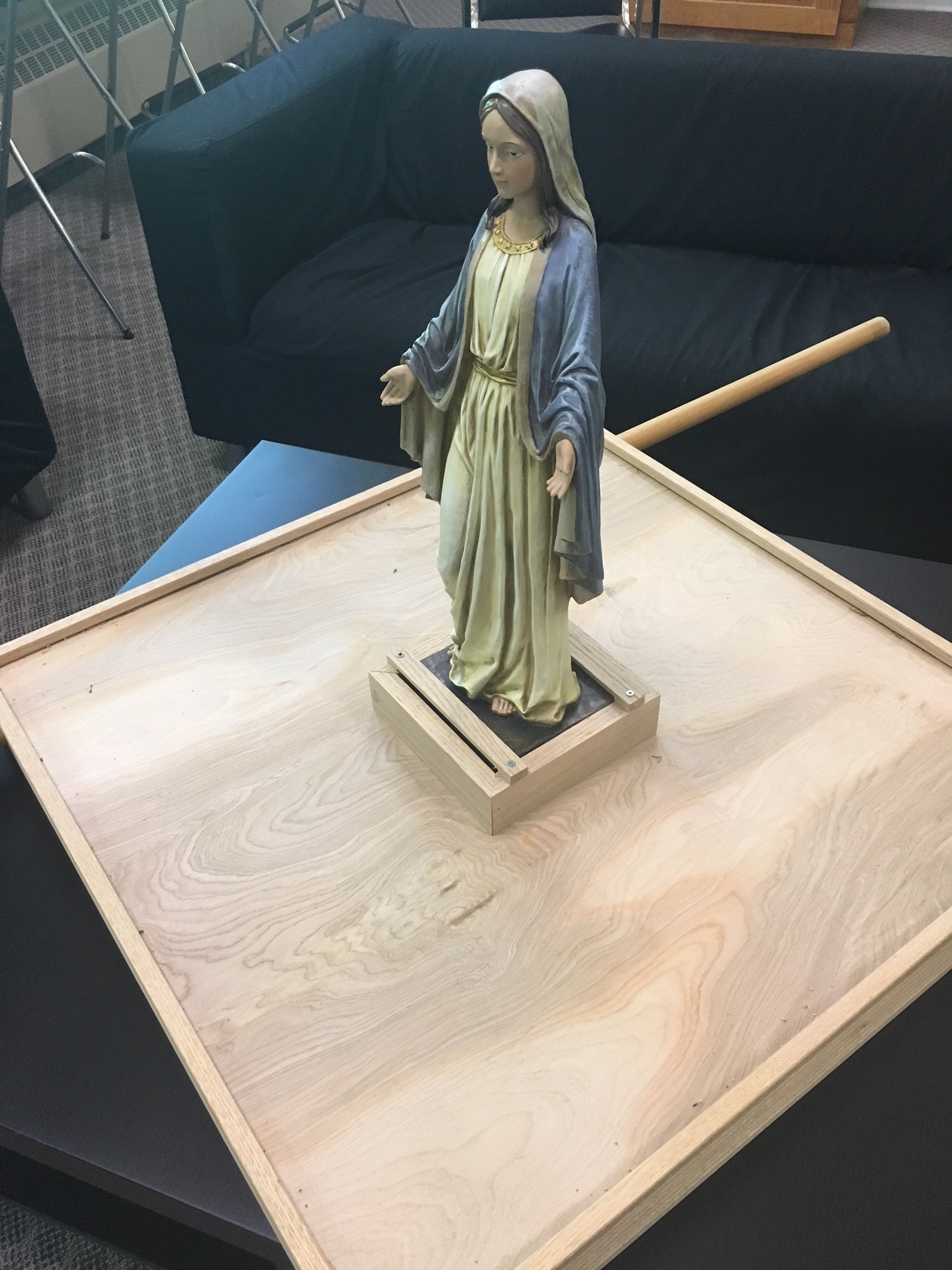
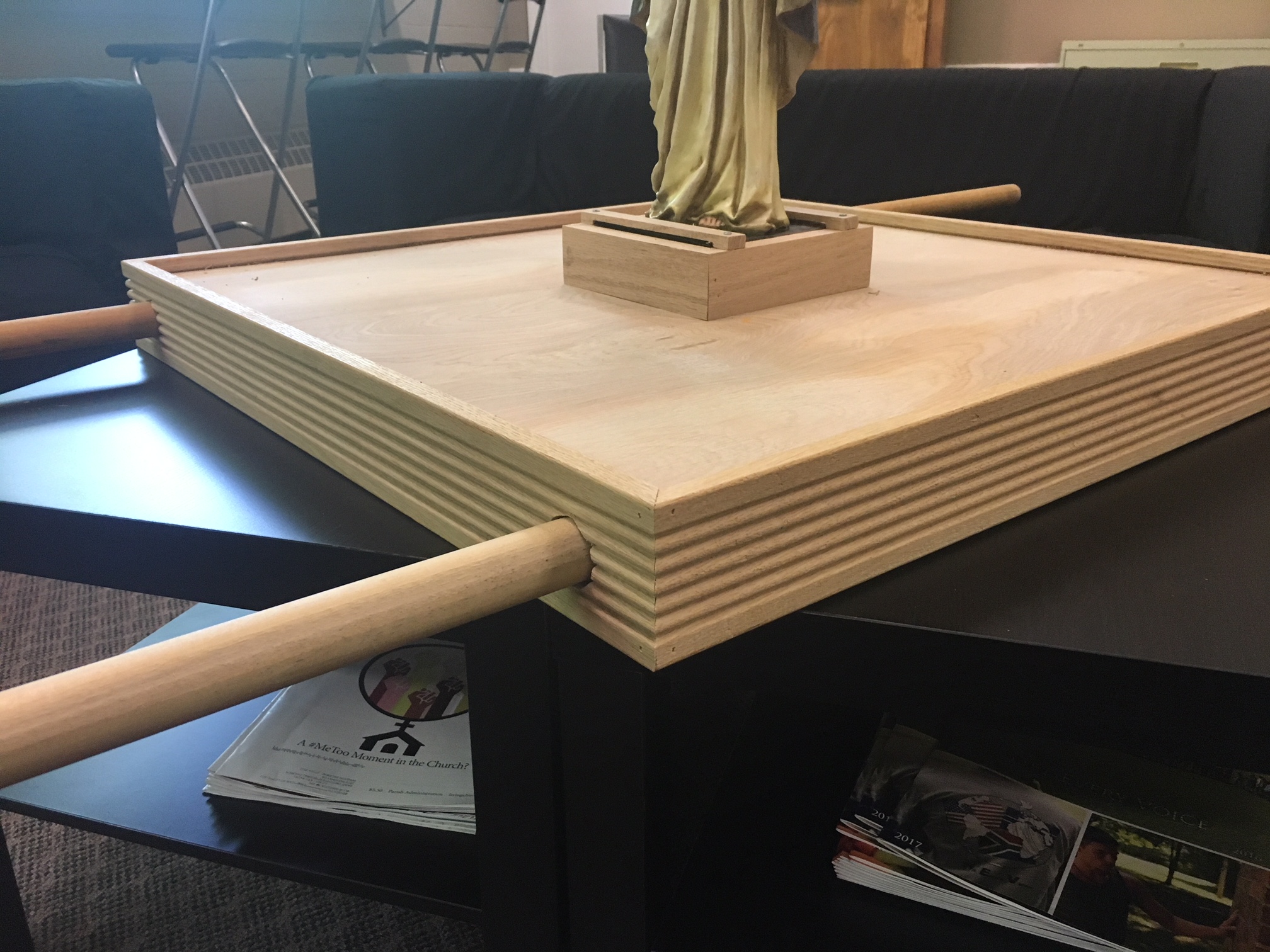
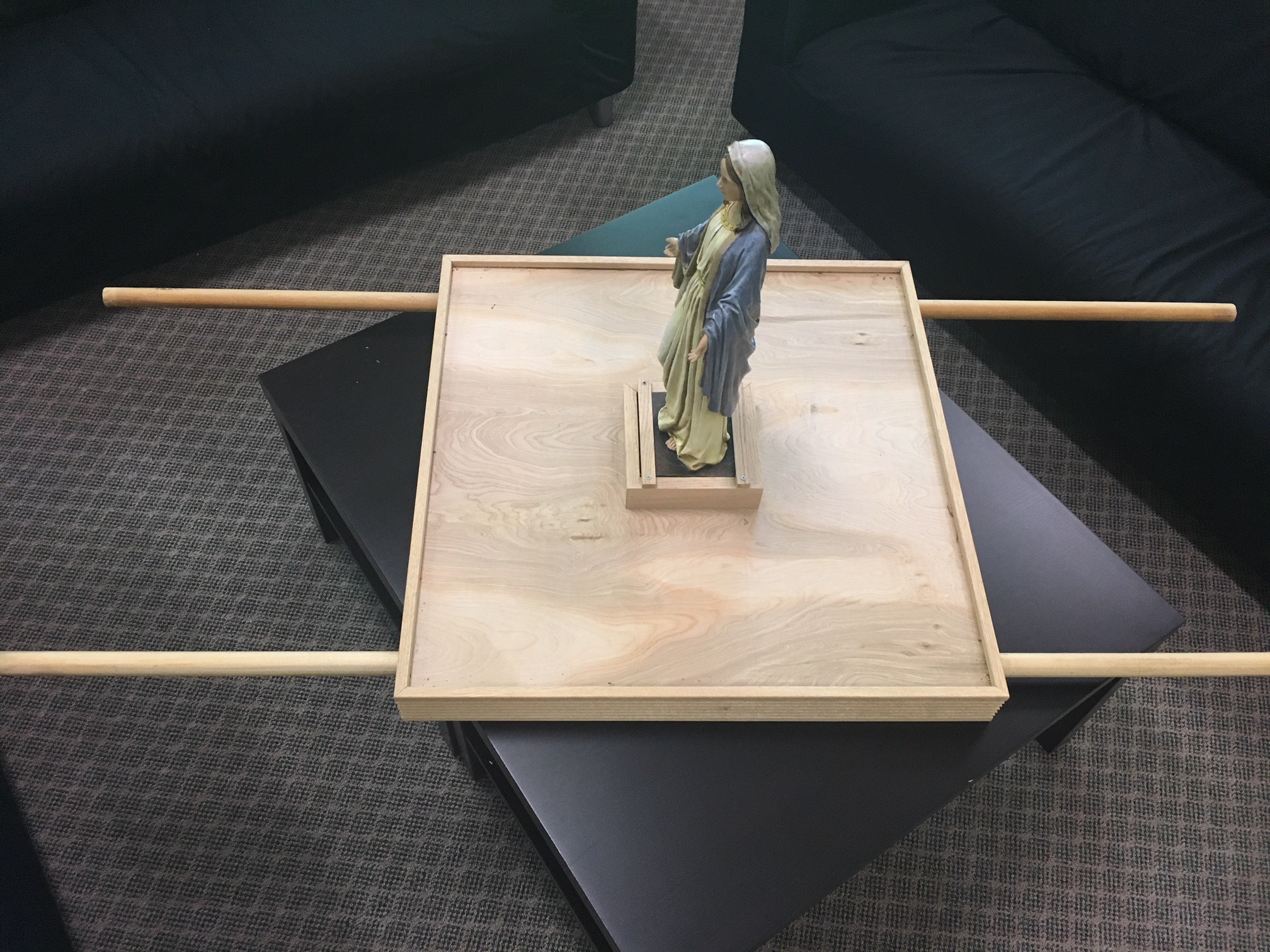
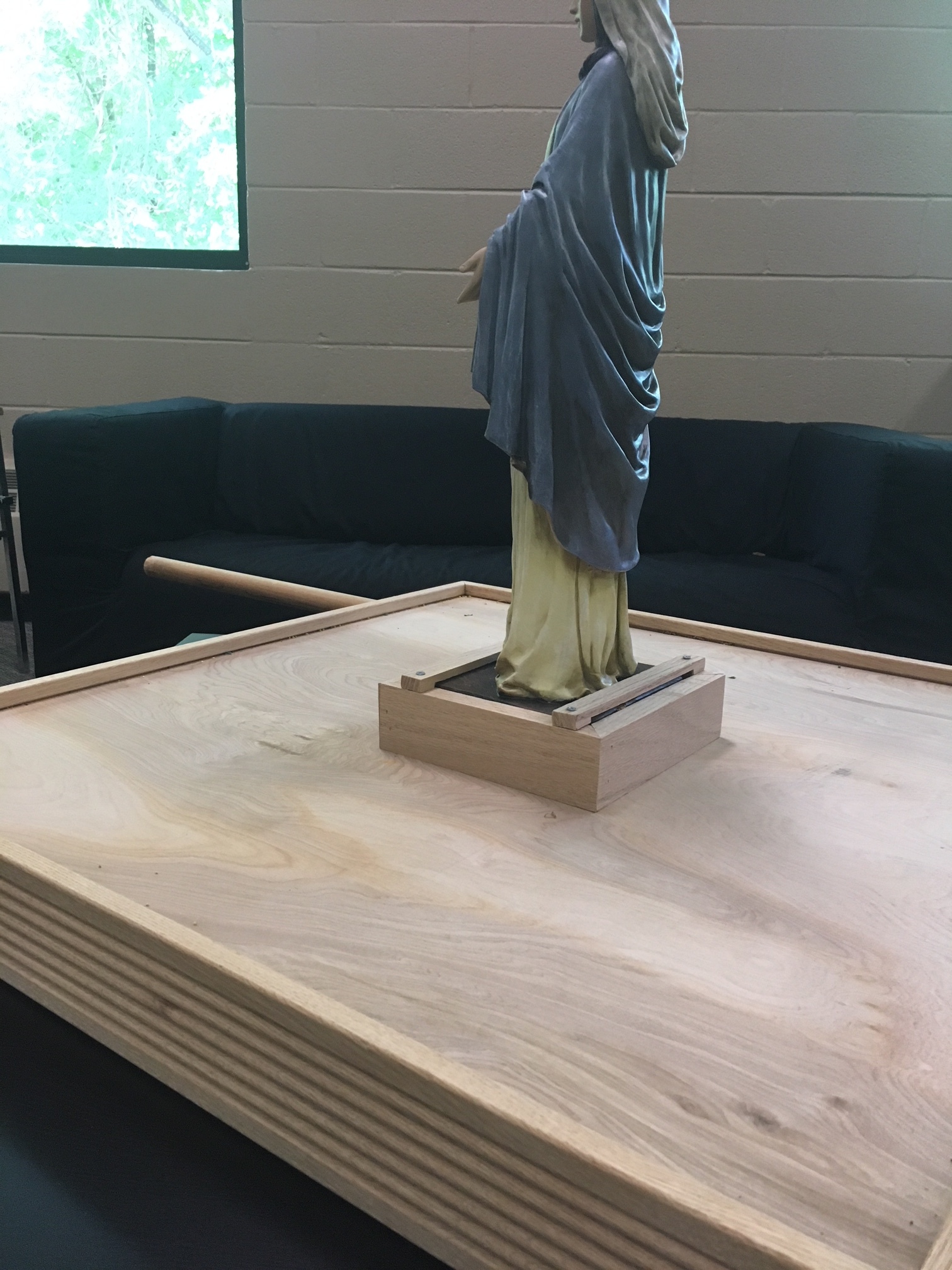
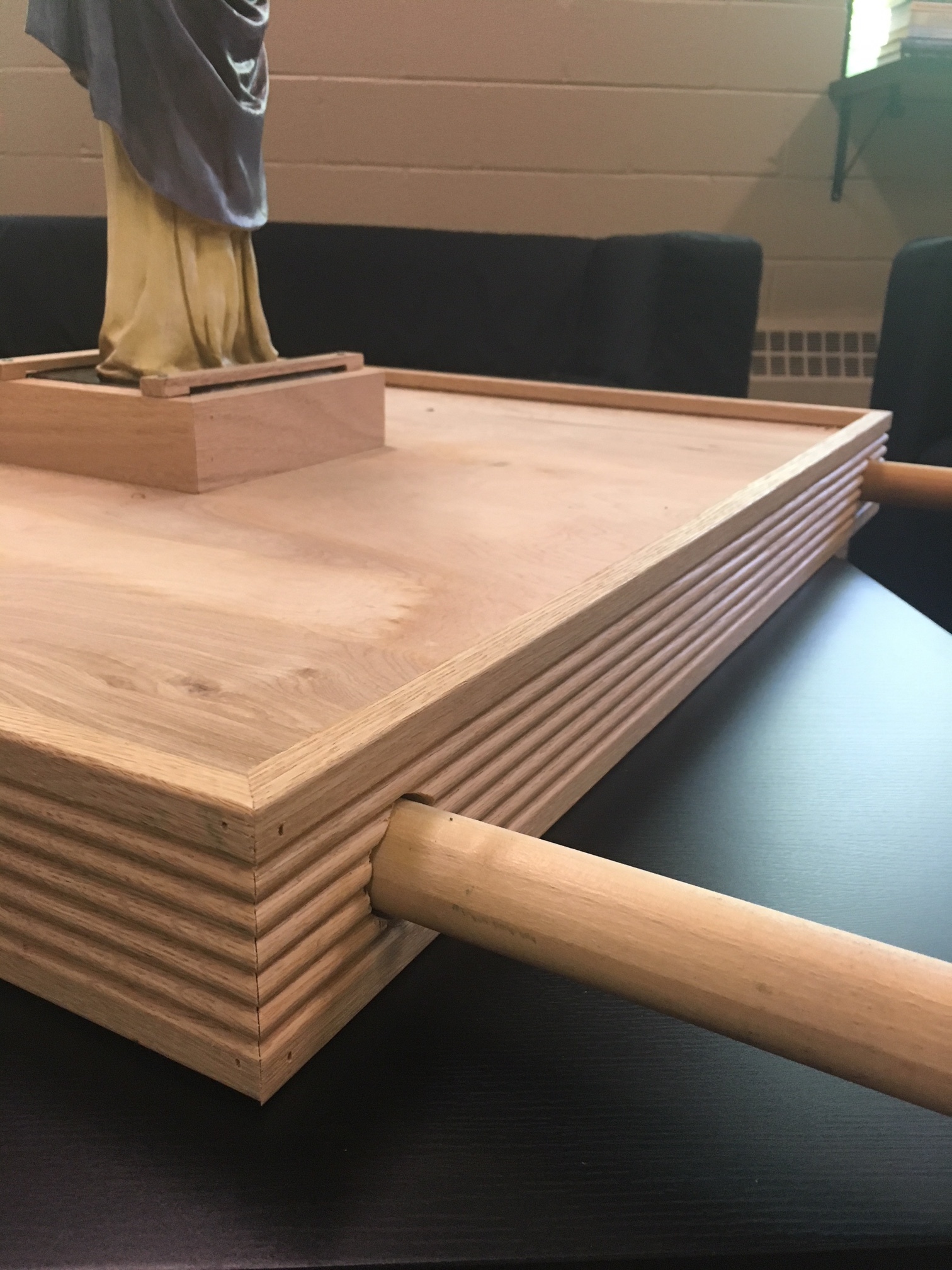
I also needed an image of Our Lady that was "suitable for transport." I did not wish to move our image of Our Lady of Walsingham from our shrine. I was able to find a 21" image for around $100. I wish she were a little bit taller than 21", but that was the best I could do without paying exponentially more. She is easily and firmly secured by two pieces of wood laid across the base. You can flip the litter upside down and she wouldn't be startled. She is not permanently in the litter and can easily be removed to another place for devotion. The top of the litter is large enough for flowers and we used the same for an organic crown.
In my opinion, this is the best part of catholic devotion. It was done by members of the parish and staff. It was a group effort. We had to think about what we were doing and what we wanted to accomplish. The end result was a litter for Our Lady constructed by the laity. It reminds me of Martin Travers making candlesticks and crucifixes from papier-mache. It is domestic devotion, which is the best kind.
